If you’re anything like me, your house is one of the best ways to get a peek into your personality. In each and every corner of my house, I have curated galleries dedicated to the things that inspired me. Treasures that tell stories of my past and keyholes in my future. The home is the most private place in a person’s world, a place where they can feel whole and safe. For Frida Kahlo, this could not be truer. Her home, La Casa Azul or “the blue house“, was the place where she was born, grew up, learned to be an artist, lived with her husband, got divorced and remarried, and where she eventually died.
It was her sanctuary but also her cage since for most of her life she was bedridden from injury and sickness. She spent more years inside these blue walls than perhaps anywhere else in the world. As such, it is one of the most intimate looks into her life that you can experience.

- Access
- Hours
- Tickets & How to Avoid the Lines
- Frida's Neighbourhood of Coyoacán
- Biography of Frida Kahlo
- Frida and Diego
- Start of the Self-Guided Tour of the Casa Azul
- Touring the Exterior
- Entry
- Gardens
- The Pyramid
- Looks are Deceiving Exhibition
- Sitting Room / Gallery
- Dining Room
- Diego's Bedroom
- The Kitchen
- Stairwell
- Frida's Studio
- Day Bedroom
- Night Bedroom
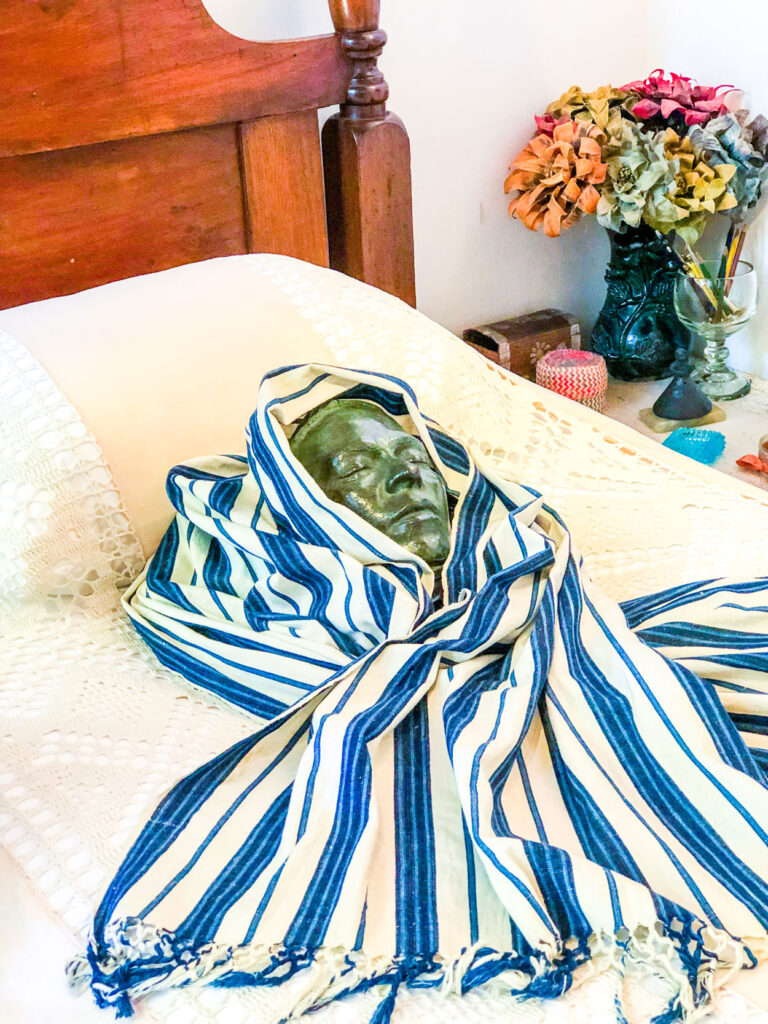
Access
The Casa Azul is located in Coyoacan. I found the easiest way to get there is by Uber. The ride from La Condesa was only $5 and took us directly to the museum. You can also access it via the Metro Line 3 to the Coyoacan Station. From there it’s just a short walk to the museum.
Hours
Tuesday: 10:00 a.m. to 5:30 p.m.
Wednesday: 11:00 a.m. – 5:30 p.m.
Thursday – Sunday: 10:00 a.m. to 5:30 p.m.
The museum is closed on January 1st, May 1st, September 15th, December 14th, December 24-25 and December 31st.
Tickets & How to Avoid the Lines
Everyone seems to go on and on about the lines at Casa Azul. And yes, there are lines. But there are also lines at the Louvre, the MET and other famous museums around the world. There are lines wherever you find places which inflame the public’s imagination and curiosity to see what’s inside. So don’t be surprised, just be prepared. The best way to do this is by purchasing your tickets in advance. You select the date and time you want to arrive. When you get to Casa Azul you hop into pre-purchased ticket line (which is much shorter). Sometimes with your pre-purchased admission, you can just walk right inside.
Tickets cost 230 pesos ($12 US) on weekdays and 250 pesos ($13 US) on weekends. If you want to take pictures and some videos, you need to pay an extra 30 pesos ($1.50 US). Videos are not allowed inside but are ok in the outdoor areas.
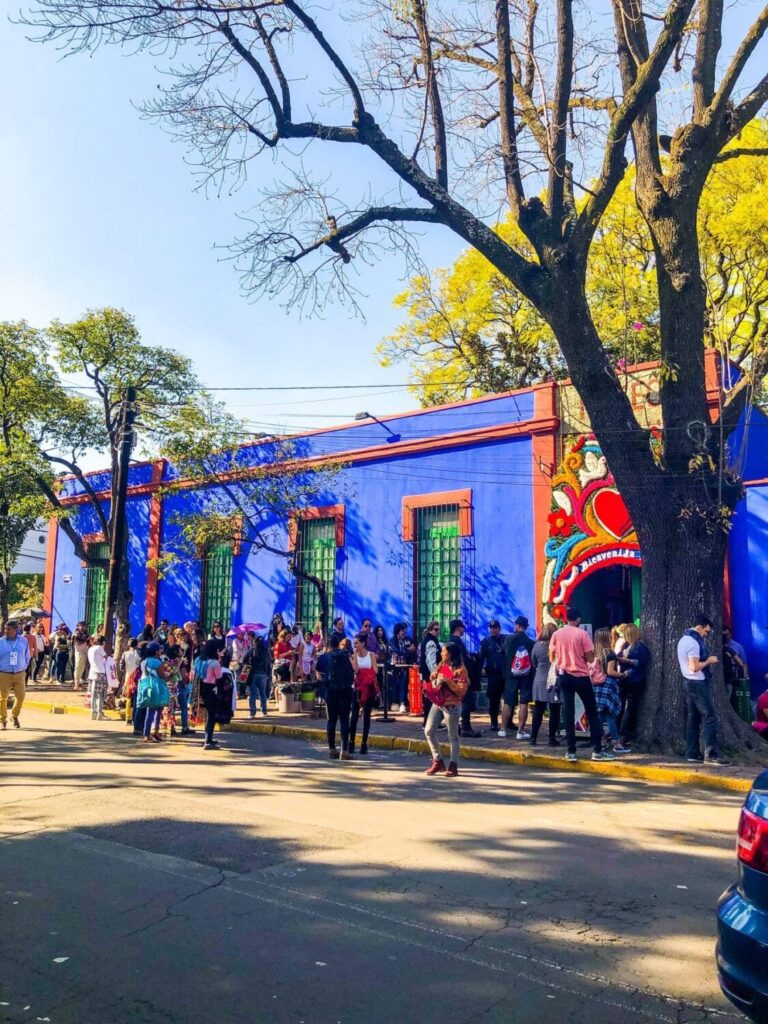
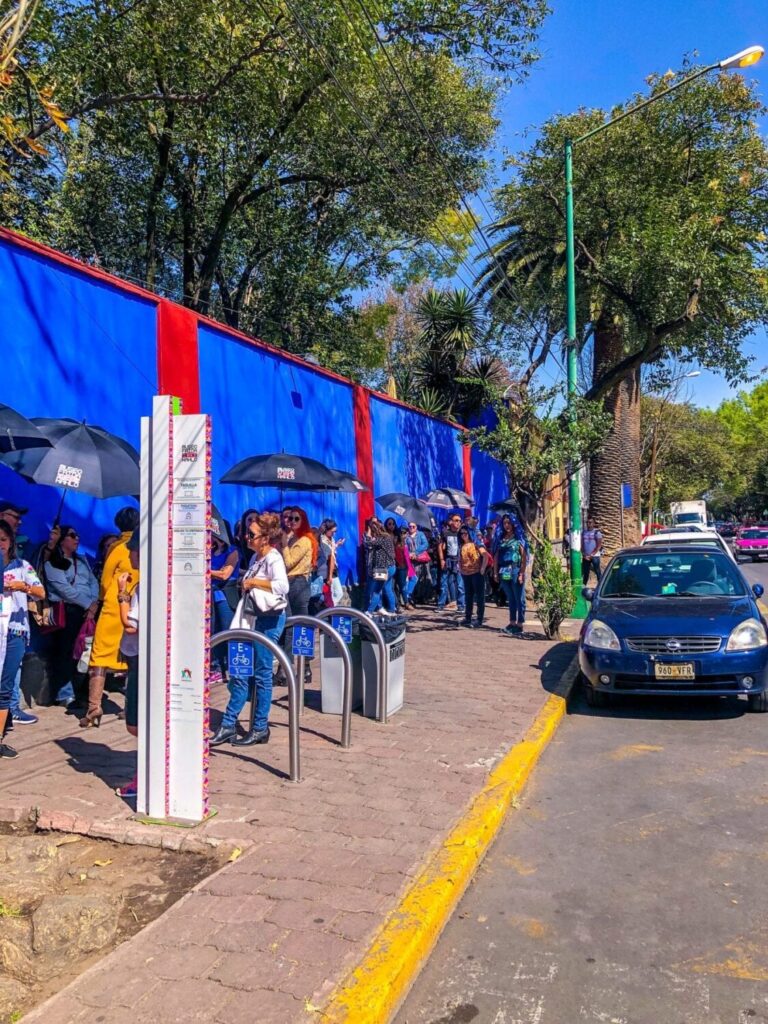
Frida’s Neighbourhood of Coyoacán
Coyoacán is a small, quiet neighbourhood on the southern end of the city. It was once nothing more than a humble village but as Mexico City expanded, Coyoacán was absorbed into the megacity. The name comes from the Aztec word, which means “place of coyotes.” The streets are some of the oldest in Mexico City, full of colourful colonial architecture which gives it that bohemian feeling it became synonymous for. Frida’s father, an artist and famous photographer, found this quirky neighbourhood appealing. For more on Coyoacán check out my self guided walking tour!
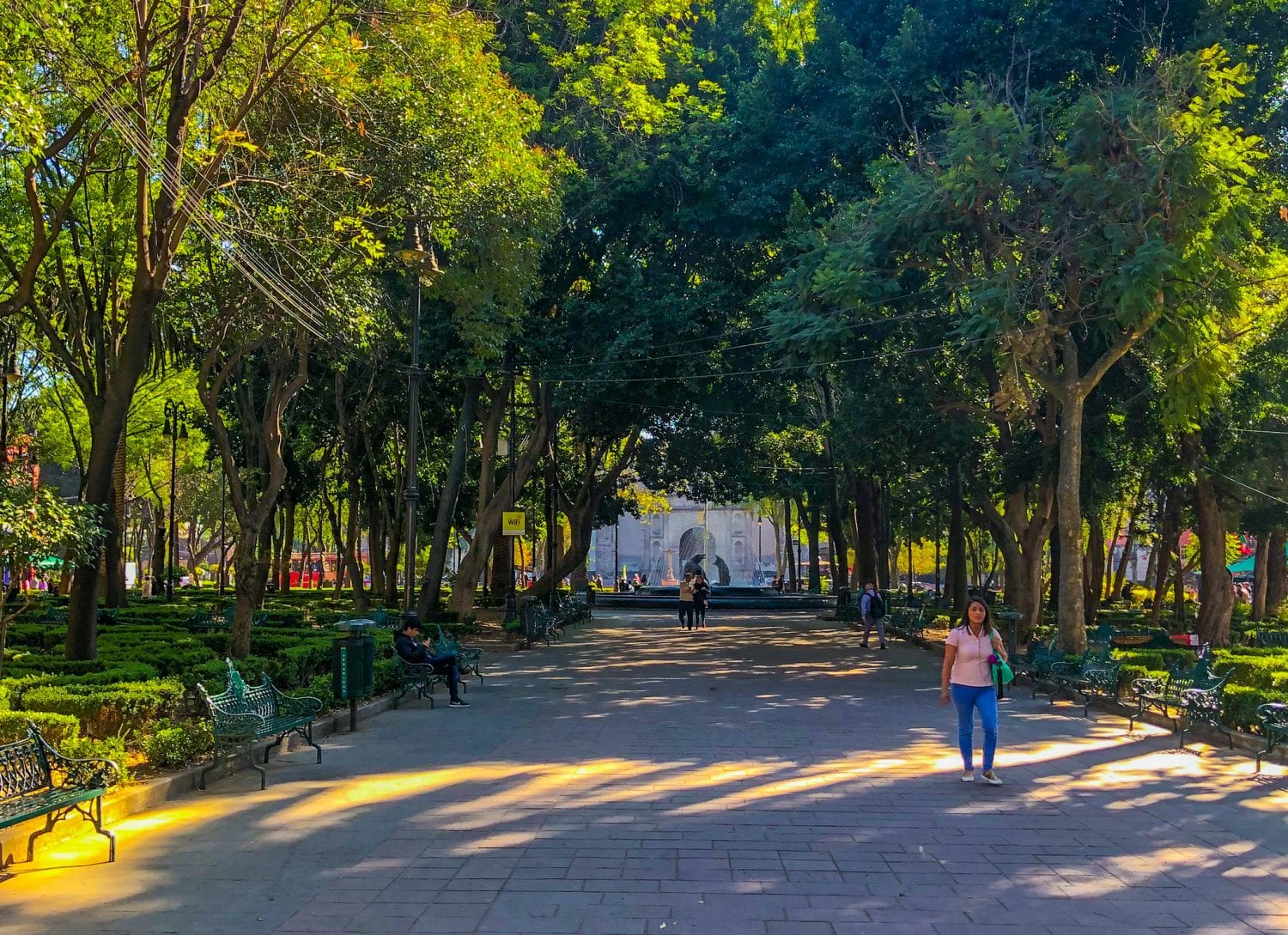
Biography of Frida Kahlo
Frida Kahlo is one of the best-known female artists of the 20th-century. Her art is most notable for being full of ideas about sex, death, the body, gender, postcolonialism, class and race. All these ideas culminate in some of the most fantastic surrealist paintings which are anything but ordinary. Frida was born in 1907 inside the Casa Azul. The house was built by her father in 1904 and would be an emotional touchstone for young Frida. Both her mother and father had had some horrible events in their lives before Frida was born. Her father’s previous wife died in childbirth. And her mother’s ex-lover killed himself in front of her to profess his undying love. It’s impossible not to wonder how these powerful moments imprinted themselves into the family. Perhaps resulting in Frida’s ill-fated, yet extraordinary life.
Frida’s Early Health Issues
At a young age, Frida developed polio which resulted in her being bedridden for many months. It also left her with a severe limp and one of her legs being slightly shorter than the other. Being home all the time as a child meant she was around her father. She followed him around his studio, where she learned all about the creative process and how to compose a painting. She began painting and drawing under his watchful eye. Without any sons of his own, Frida became his creative successor.
He enrolled her in an art school in 1922, where she initially met Diego Rivera who was at the time, was painting a mural in the university’s auditorium. She was enthralled with him as soon as she laid eye on him and his art. She was so sure of him being one of her conquests that and would tell her friends she was going to marry him, even before speaking one word to the artist.
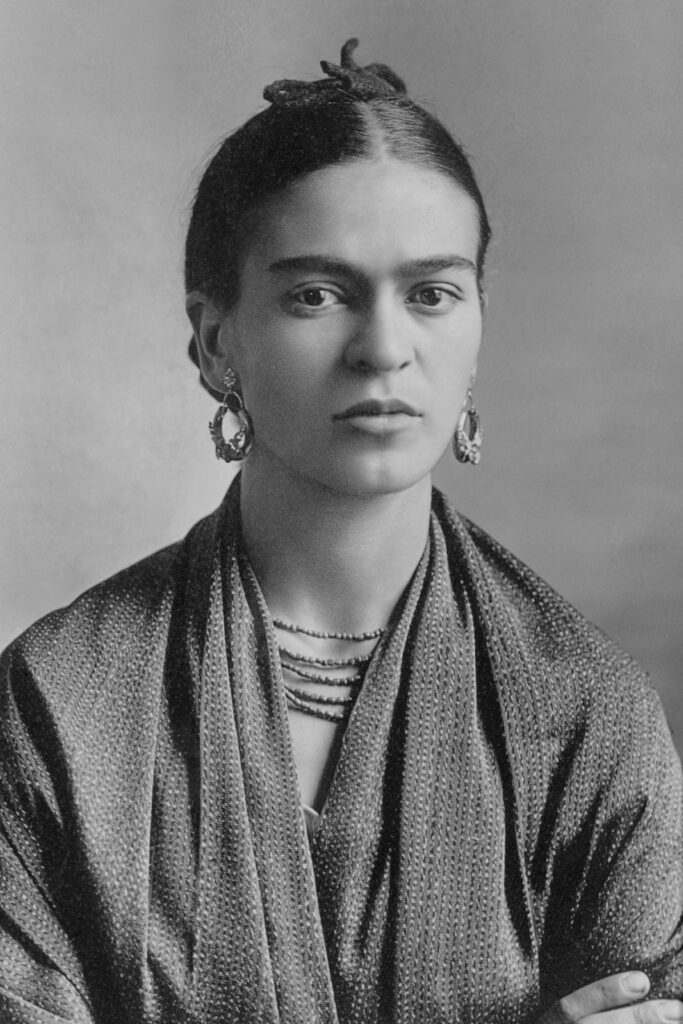
The Accident
One the way home from school one day, Frida’s was caught in a severe bus accident. A train crashed into the bus she was on, and it practically exploded on impact. Various people died instantly, and a few died in the hospital. Frida was left for dead, the ambulance refused to take her to the hospital as they assumed she would be dead before they arrived. But Frida was a fighter although her injuries would leave her disabled for the rest of her life.
She underwent over 30 different significant operations. The hospital staff thought she would never be able to get out of bed again. But by the end of the month, she was taking her first steps outside. Years of surgeries and recovery meant being confined to her bed once more. Her father made her a custom easel where she could paint in bed while lying down. She used this time to paint portraits of herself, as a way to comprehend the reality of what had happened to her. As her painting improved, and she was able to walk freely, she knew she had to help her family financially. Her operations had cost them greatly, and she needed to find out if she could make a career out of her art.
Frida and Diego
Frida went with various pieces of her artwork to get a critique from the famous Diego Rivera. When she met inside him, she claimed it wasn’t to flirt or get his attention. She wanted harsh criticism from the iconic artist and learn how she could improve. Diego was quite impressed by her artwork and was immediately taken with Frida’s bold personality. Frida was not your typical beauty. She embraced her more masculine characteristics. Frida had a monobrow and a bit of a moustache, but instead of hiding it or trying to remove it, she flaunted it. Some people said that she was one of the great beauties others found her almost hideous. It was this juxtaposition of opinions that Frida loved, using her sexuality as the great divider.
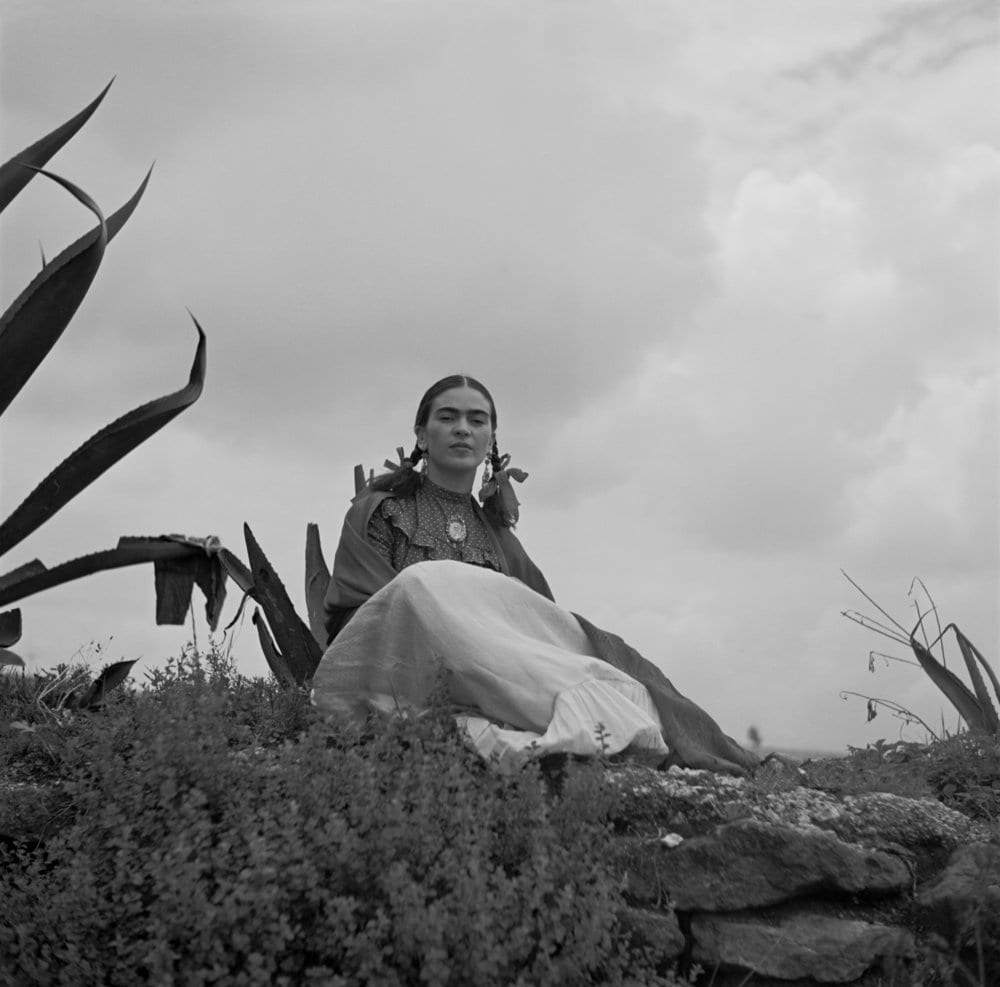
Frida and Diego’s Marriage
After only a short period of knowing Rivera, the two were married in 1929. Her mother and father roundly objected to the marriage, and so the two of them had a small, civil ceremony, presided over by only by a hairdresser and homeopathic doctors. Their relationship was fiery and passionate — each one is inflaming the creativity of the other. Diego encouraged Frida’s penchant for wearing traditional Tehuana dresses they both viewed them as the most authentic part of Mexican heritage. They became a kind of uniform for her, which she would wear for the rest of his life.
Frida and Diego moved into the family home, the Casa Azul, as her father was no longer able to afford to live there due to his declining career. Diego was at this point, a wealthy and well-known painter and could easily afford to keep the home in the family. Before they moved into the house, the house was painted s a rather dull colour. Frida and Diego made it their mission to repaint the entirety of the house bright blue, making their mark on this space.

Love Affairs
Diego was a womanizer, and despite Frida’s acceptance to their open relationship, she found herself overcome with jealously when Diego had an affair with her sister, Cristina. The news of their affair devastated her. Frida suffered numerous miscarriages and eventually was told by doctors due to her injuries from the bus crash she would never bear children. Painting became everything to her, and it was like her artworks became her children. Frida explored more and more images from her Mexican heritage. She said that Mexico was her great mother who raised her. As she became a painter in her own right, she was less affected by Diego’s affairs. In fact, she began having her own set of relationships with men and women alike.
The longest of her affairs was with famed photographer Nickolas Muray, with whom Diego was furiously jealous. Although Frida ended up divorcing Diego in 1939, they got remarried only a year later. It seemed that no matter what happened between these two, they could not be without each other. While it certainly was an alternative lover story, I found that to be the real charm of their relationship. It’s not perfect, it’s not a fairytale, but it’s real and laid bare for us to witness in her artworks.
Frida’s Death
Despite her blossoming career, Frida’s health began to decline. Eventually, her old injuries only worsened to the point where she had to have her right leg amputated. Her pain was almost unbearable, and she attempted suicide multiple times to escape it. Diego built for her a second floor to the Casa Azul where she could paint and work without having to leave the house.
She eventually was bound to her bed along and passed away on July 13th, 1954, at the age of 47 in that very bed. Her body was brought to the Palacio de Belles Artes in the historic centre of Mexico City where hundreds of mourners came to pay their respects. During her lifetime she was known as the wife of famed painter Diego Rivera. But today it is HER who has become a part of popular culture and art history. Diego gave the Casa Azul over to the government of Mexico City and it was opened up as a museum in 1958.

Start of the Self-Guided Tour of the Casa Azul
Touring the Exterior
If you have to wait outside before heading into the centre courtyard, take a minute to observe the outer exterior architecture.
“The house, painted blue inside and out, seems to shelter a bit of sky.”
Diego and Frida painted the house this bright blue colour when they moved in. Colour was of the utmost importance to Frida in her life and in her art. This vibrant azure was a hue associated with the feeling of freedom and expansiveness, like looking out on the eternal sea. And for a woman who was often unable to leave her own four walls, a feeling of freedom was the difference between sanity and madness. The house, built-in 1904 by her father, was built in a typical Spanish style of the age with a central courtyard surrounded by various rooms all on one level. The original exterior had a bit of French flair, but Frida removed all these gaudy elements in exchange for the primitive and simplistic decorations inspired by the indigenous people of Mexico.
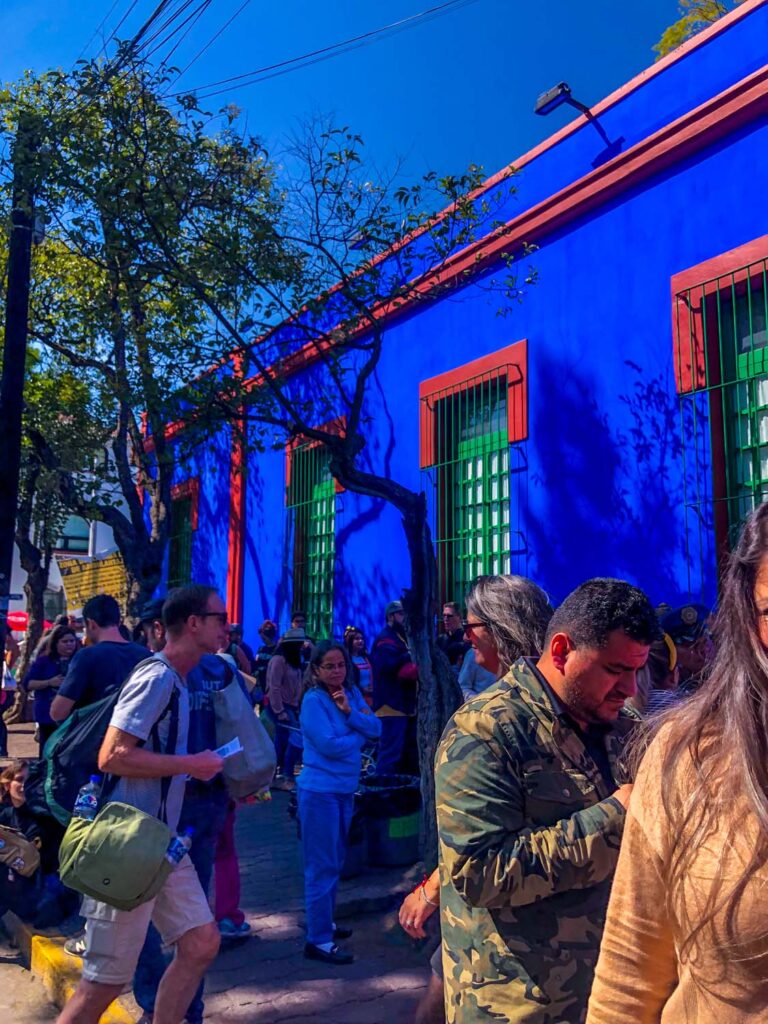
Entry
As you walk in the main gates, under the giant floral ofrenda to Frida, you’ll pass under various of Frida’s papier-mâché alebrijes. Alebrijes are brightly coloured Mexican folk art sculptures of fantastical creatures. They were originally created in 1930 by the artist Pedro Linares. Linares fell gravely ill and during his fever-induced hallucinations found himself dreaming of a strange forest full of wild and colourful creatures. He saw donkeys with butterfly wings, a rooster with horns and lions with the heads of eagles, all shouting the word, “Alebrijes“. When he recovered, he set to making the creatures out of wood to bring his visions into his reality. He was good friends with Diego and Frida, and she was inspired by his story and made some for herself. These somewhat terrifying creatures, now greet all guests who come through the doors.
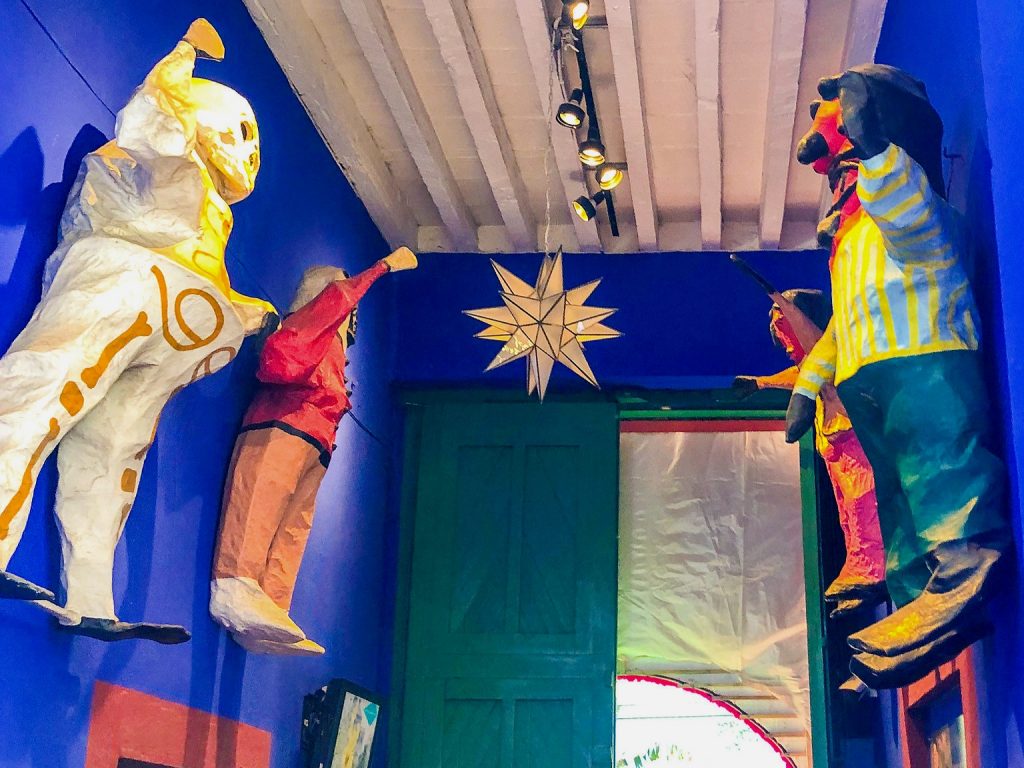
Gardens
The first space you’ll enter is the lush gardens. Walking in here is literally a breath of fresh air! You can smell the blossoming flowers everywhere you walk, like a scented canopy. Frida made her gardens an almost sacred space. She took care of each and every plant very seriously, almost as if they were her children. She adored watching them bloom and grow. All the plants were harvested from all across Mexico, so it’s like a tiny snowglobe of Mexican horticulture in one place. You’ll find yuccas, bougainvilleas, cacti, jasmine and agave blooming throughout the year.

Across the walls of the courtyard are various pre-Columbian idols, as Diego loved collecting these treasures of Mexican heritage. He would go to the old ruins of Teotihuacan almost every weekend in his early life looking for artefacts he could bring home with him. The walls which supported the new second story, made by Diego and Frida, were created from lava rocks and embedded shells the couple found on the shores of the beaches of Mexico.

Frida’s Teaching Career
In this garden, Frida held classes for her students. She began teaching in 1943 at Las Esmeralda Art School, but she found it too hard on her disabled body to come to classes at the school in the centre of town. Her dedicated student, dubbed “Los Fridos” would come to La Caza Azul where she could mentor them under the shade of these great palm trees. Their time with the great artist in her intimate home was something that imprinted greatly on them.

The Pyramid
In the middle of the garden is a minature, red and yellow painted replica of an Aztec pyramid. This was built by Juan O’Gorman for Diego Rivera in 1946. The artist used materials like volcanic stones and basal to build the structure. Along the base of the pyramid are various replica ceremonial statues from places like Teotihuacan or Tulum.
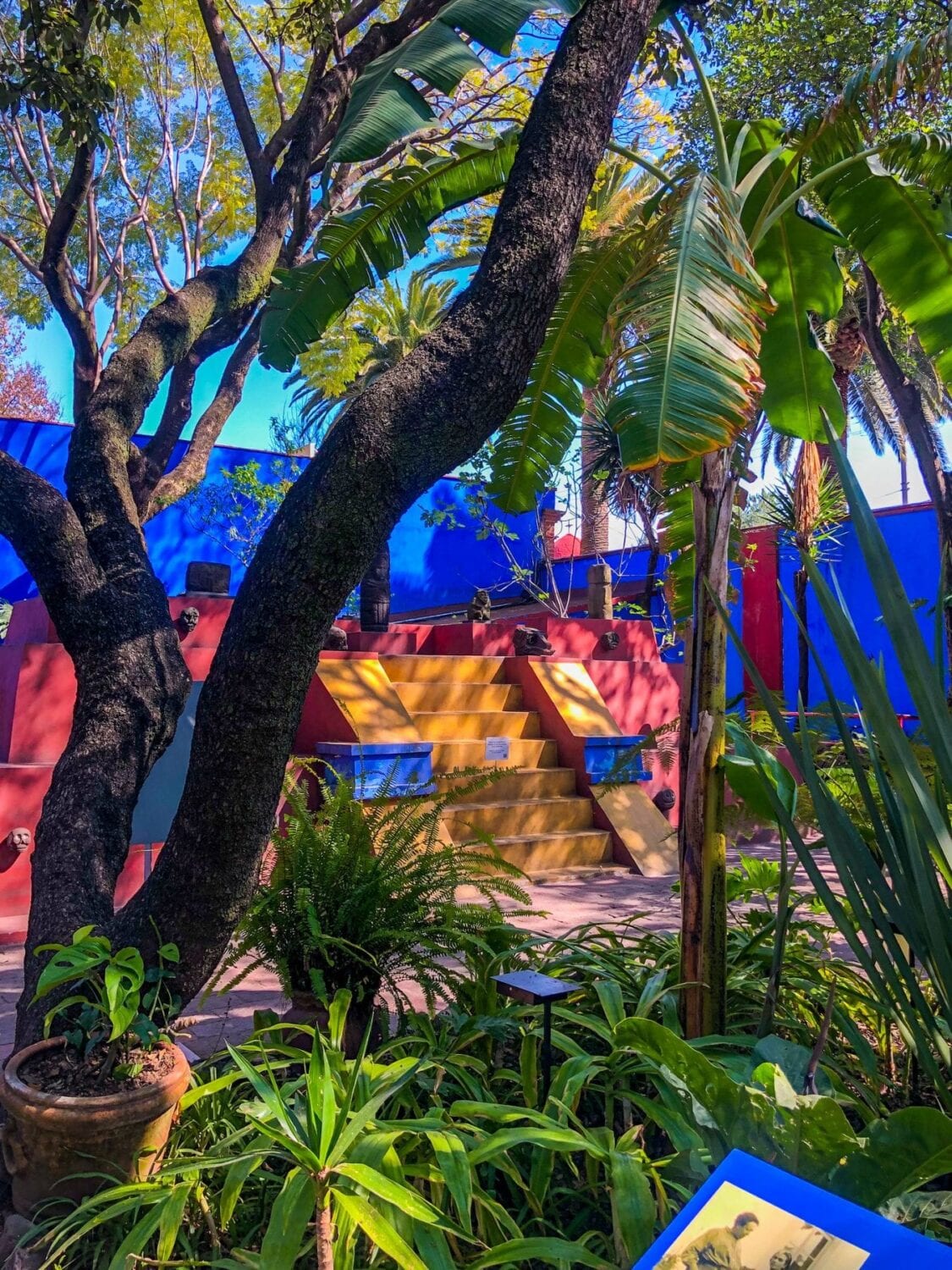
Looks are Deceiving Exhibition
At the back of the courtyard is an exhibition room which contains some of the most personal items of Frida Kahlo. This exhibition is entitled, ‘Las apariencias engañan‘ or Looks are Deceiving. This exhibition features a treasure trove of Frida’s clothing, corsets, makeup and jewellery. All of these items were only discovered in 2004. When Diego handed the house over to the Mexican people for use as museum he asked that several bathrooms (which has been locked) were not to be opened until many years after his death. When they opened the doors, they were shocked to find all these iconic dresses which featured in many of the most famous portraits of the painter.
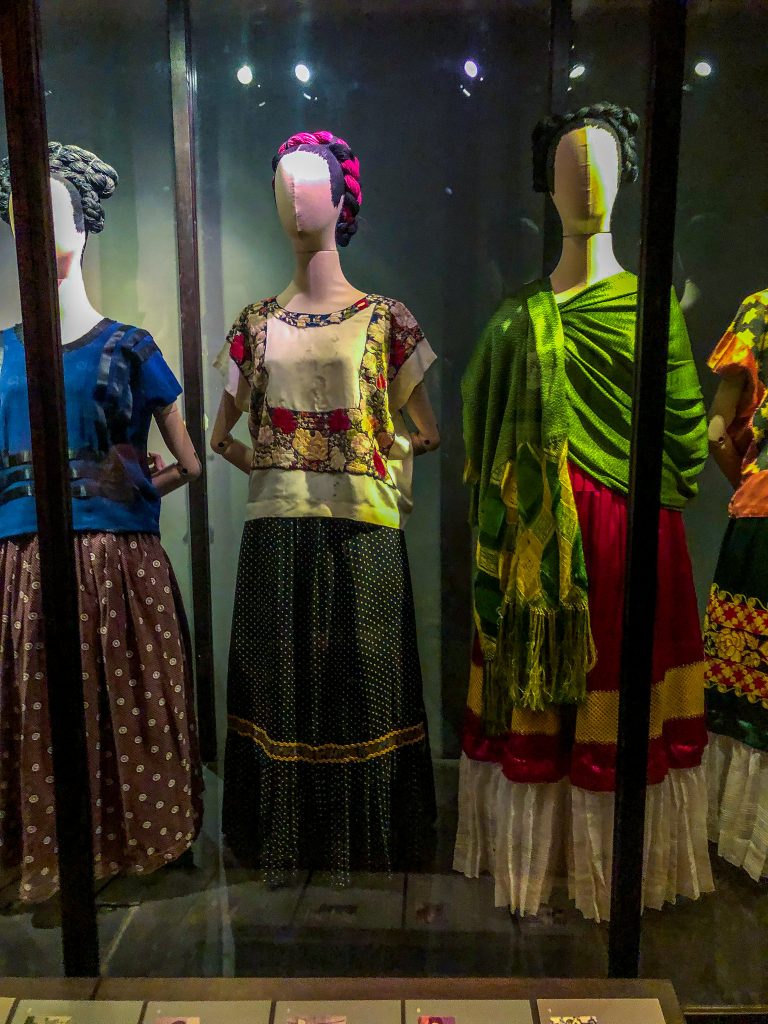
Frida’s Dresses
Her Tehuana dresses have become the iconic image of the painter. And even I wished I could have taken a few copies of them for myself! Tehuana dresses come from the Tehuantepec Isthmus located in the southeastern part of Mexico in the region of Oaxaca. Oaxaca is known the world over as being the heart of the textile industry in Mexico. The woman of the area are seen as the dominant sex, and it is mainly a matriarchal society. As such, their dresses needed to reflect this power.
Frida wanted to be seen as Diego’s artistic equal and adopting these dresses, and their accessories made her feel closer to that powerful matriarch. The clothing also helped to cover up her legs which were affected dramatically by the polio and the right left which had to be eventually amputated. The white petticoats which peek out from underneath the dresses were not only beautiful but practical as they could be detached from the rest of the gown to be washed. Since these long dresses would drag on the ground, the ability to only wash this portion of the dress was very inventive.
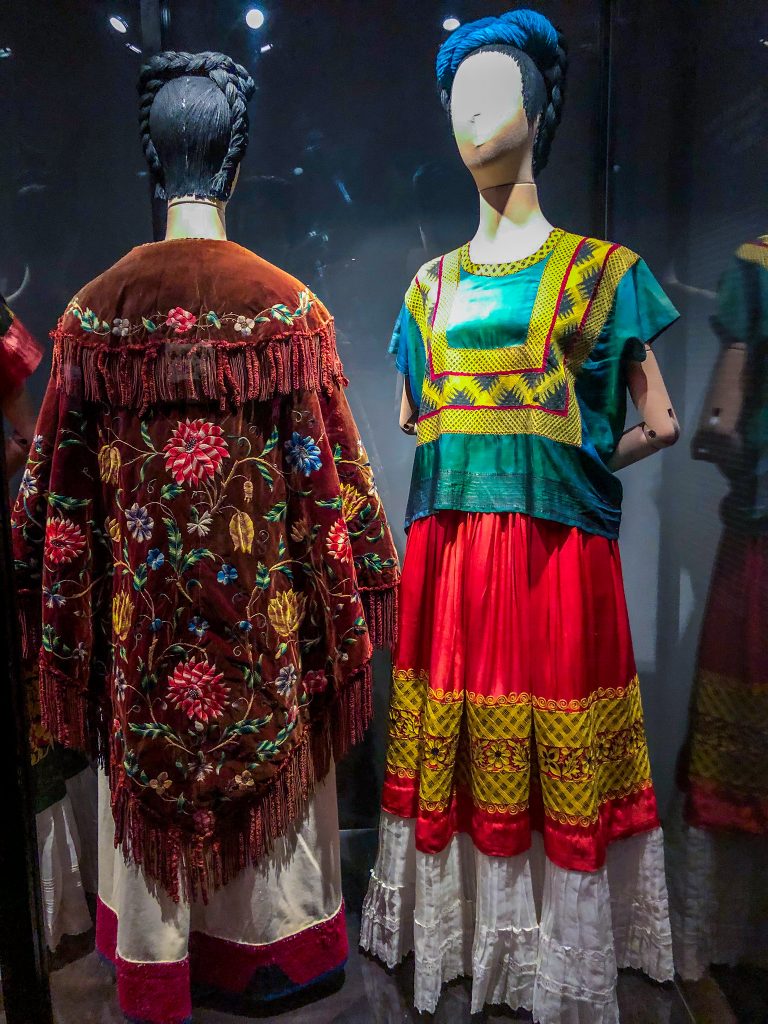
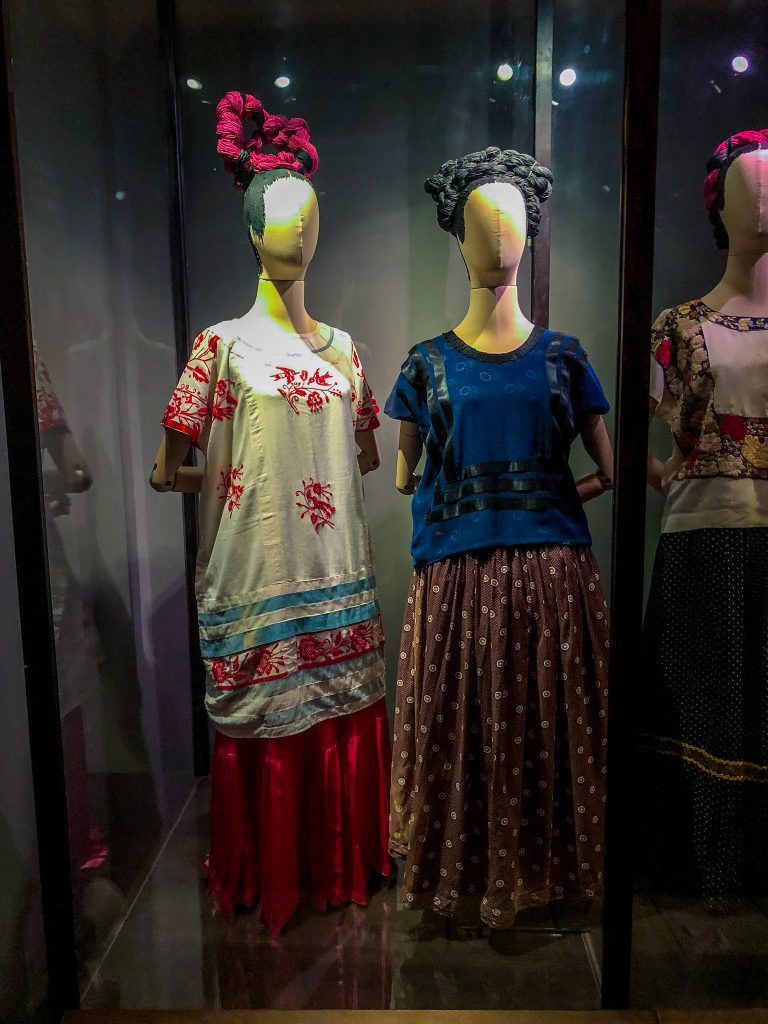
The Corsets
The corsets are one of the rawest and most eye-opening portions of the exhibition. They show us just how much pain this beautiful artist must have been suffering through every day, even though she forced a smile. But Frida did not only hurt physically, she also suffered emotionally. Frida’s once said of her husband’s infidelity,
“I suffered two grave accidents in my life. One in which a streetcar knocked me down. The other accident is Diego.“
She used her clothing as a defence against feeling weak and small. Instead, these clothes were loud and powerful. And wearing them made her feel this way even if underneath she did not.
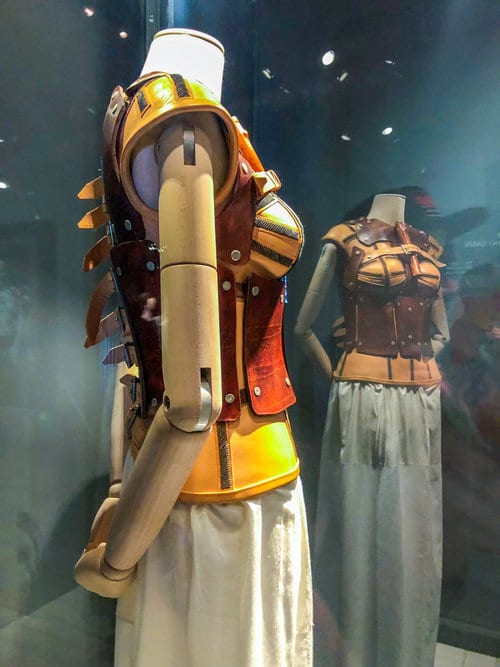
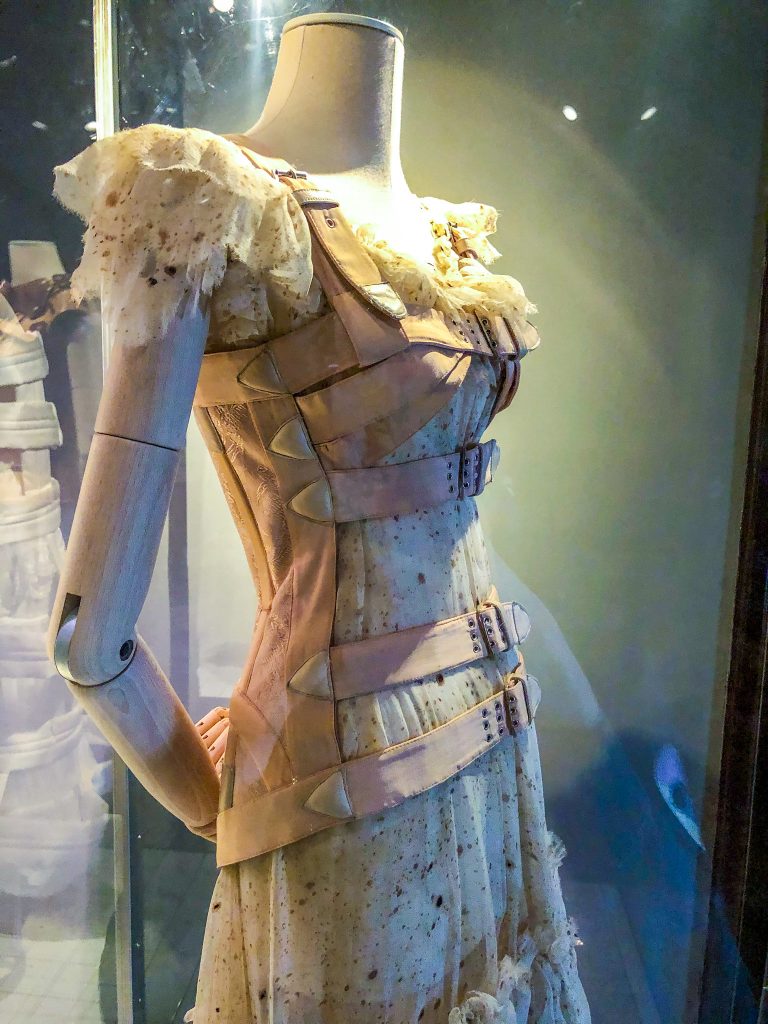
Frida not only had some of the most gorgeous dresses but she also adorned her body in lush jewellery, highly embroidered footwear, and expensive perfume. When she was recovering from her multiple surgeries her wounds would fester and to cover up the smell she relied on flower headpieces and perfume to mask the smell. Even in bed, she would always be seen wearing dozens of pieces of jewellery.

Sitting Room / Gallery
Entering into the house, you first pass through what was once the old sitting room, or living room as we call it today. Here Frida and Diego would entertain their famous guests such as Nelson Rockefeller, George Gershwin, caricaturist Miguel Covarrubias, and actresses Dolores del Río and María Félix. Today, this area is used as an introduction to Frida’s life through her work. Some people have been disappointed not to see more of her artwork in the house, but you just need to set your expectations. I came in not expecting to see any at all, so I was pleasantly surprised to be able to get up close to these pieces.

Portrait of My Father, 1951
One of the paintings Frida made in 1952, just two years before her death, was a gorgeous dedication to her father. Her father also had his fair share of suffering throughout his life. He was an epileptic who had to leave behind his family fortune in his home country to escape the Nazis as he was a Hungarian-born Jew.
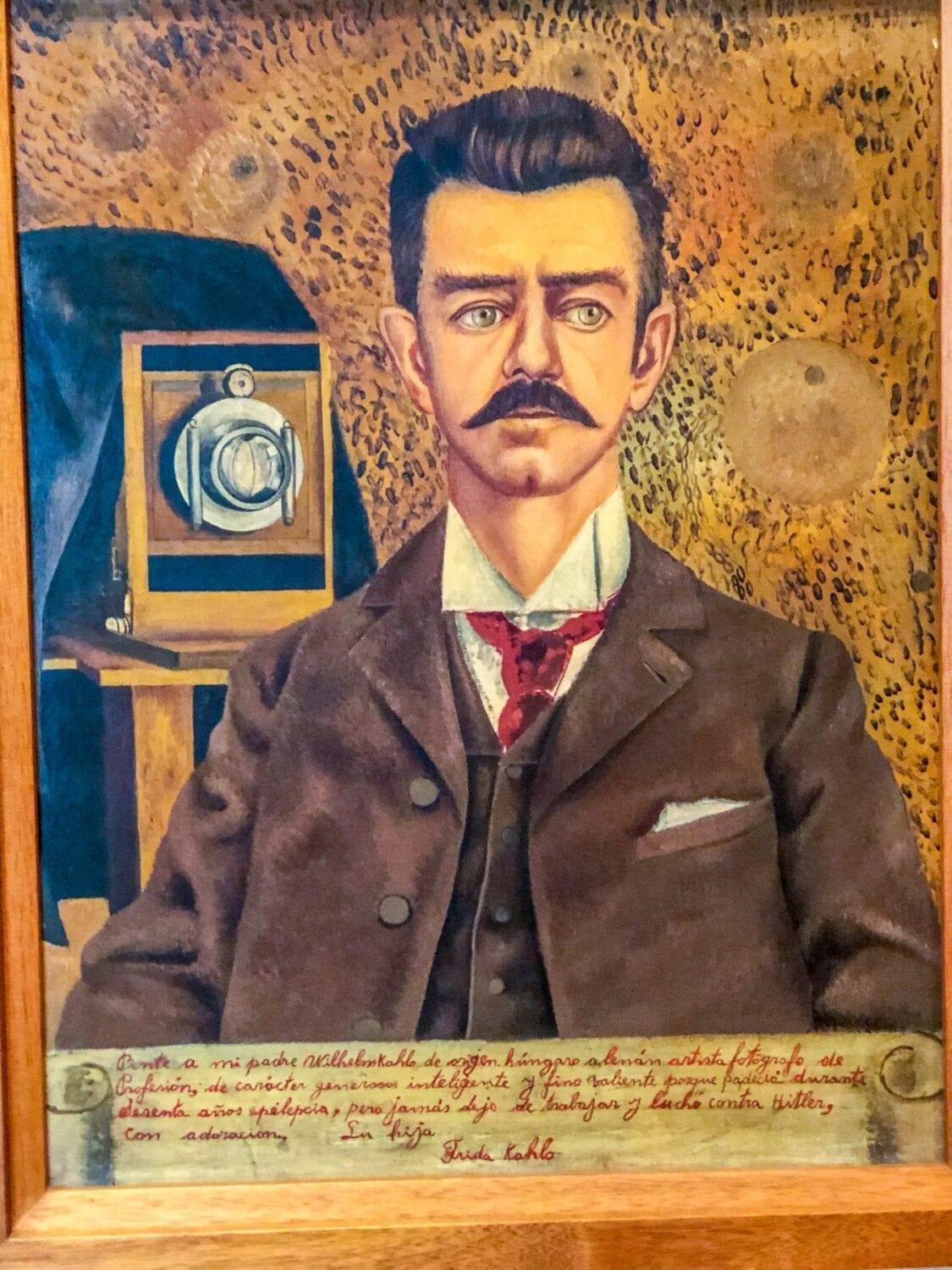
Frida and the Cesarean, Unfinished 1931
This painting depicts Frida in the hospital in Detroit after her second miscarriage. In this vision, Frida is attempting to deal with the trauma of her second failed pregnancy. This is a dream which portrays what would have happened if she had been able to carry the baby to full term and deliver it by cesarean. The child lays beside her on the bed, the image of Diego looking down on her. She was never able to finish this painting. It was nothing but a lie and she prided herself on painting what she perceived as reality. Days later, she would go on to paint “Henry Ford Hospital” which depicted the real horror of the miscarriage as it truly was.
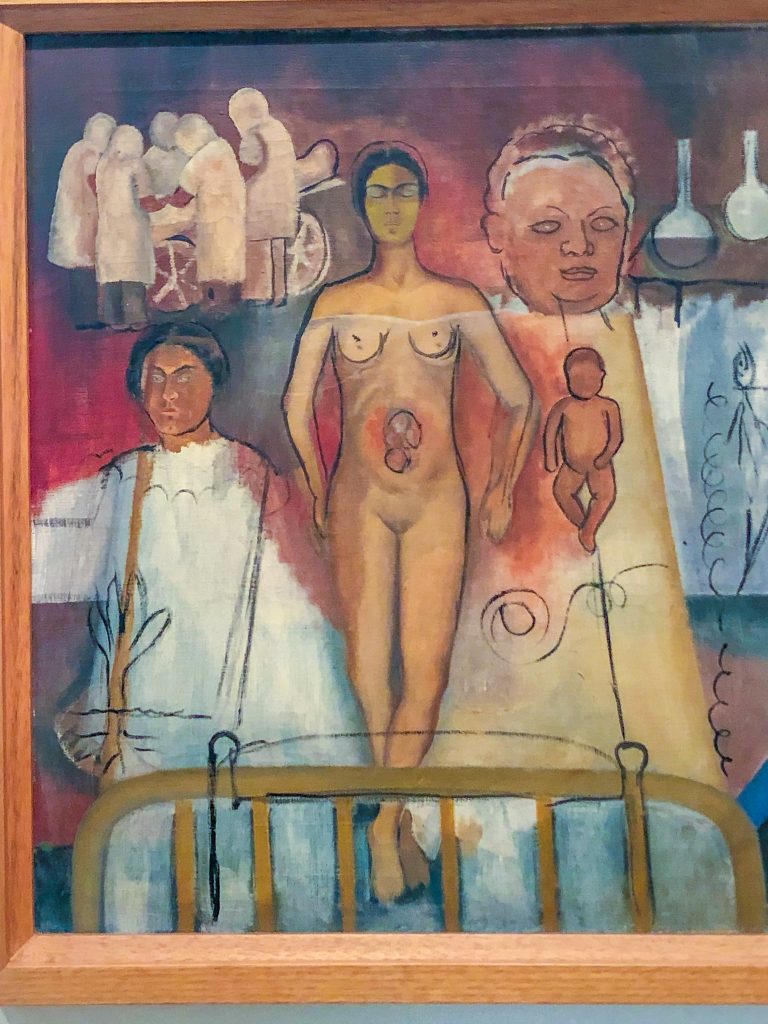
Still Life, 1942
Frida was a woman who embraced her sexuality, and as such her paintings are full of sexual references and illusions. This still life was painted for the Mexican presidential residence but was returned to the artist most likely due to it being a little too vulgar for the upper class. The open papaya resembles the shape of a womb. To the left, we see coral fungus resembling the ovaries, and to the right, we have an open cherimoya fruit which resembles female genitalia. While some onlookers will see nothing but a bowl of fruit, Frida was tempting her audience to open their minds and their six senses.
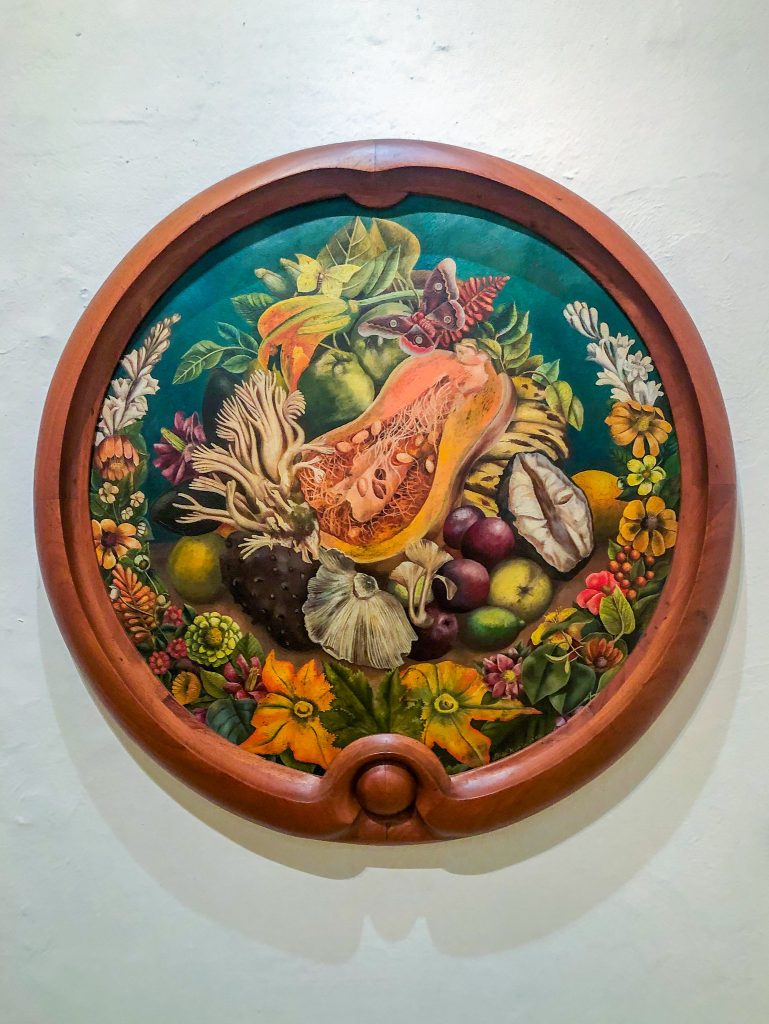
My Family, Unfinished 1949
This painting feels like the most appropriate piece for the setting inside their family home. It’s a family tree with her grandparents at the very top. Underneath them are Frida’s parents and herself and her siblings on the bottom. A fetus is seen in the centre of the four children. This is her brother who died only a few days after his birth. But to Frida, he is still very much a part of their family even after all these years. Three figures are unfinished to the right of the frame. These are thought to be the children of her youngest sister Cristina with whom Frida had a tumultuous relationship with after Cristina’s affair with Diego. Perhaps the fraught relationship was the cause of Frida’s inability to complete their images on the family tree. Frida being too jealous of her sister’s ability to bear children when she could not.

Viva la Vida, 1954
This was the last painting which Frida would complete before she died. It is a still life of watermelon’s, which are a popular image in Mexican art. Watermelons are seen around Dia de los Muertos (Day of the Dead) when the fruits are eaten by the dead who return to the land of the living. Although the melons are bright and colourful, there is a thread of ominousness in their use as it feels Frida is predicting her own demise. Eights days before she died she wrote these words upon the watermelons “VIVA LA VIDA – Coyoacán 1954 Mexico” (Long Live Life!). In her diary a few days before she died she would write,
“I hope that the exit is joyful, and I hope never to return”

Retablos
One of my favourite parts of the exhibition of her artworks were her retablos. These tiny votive images were created when Frida was living in Detroit. While Diego worked on his large Detroit Industry Murals, Frida occupied herself with these creations. During the time huge, political murals were all the rage, and yet Frida was creating small, religious images. Each one of these were painted onto small metal sheets. When the society as a whole was all about grandeur, Frida was creating miniature worlds you had to get close up to really understand. In a way, you needed to become more intimate with them, unlike the murals which you could understand from afar.
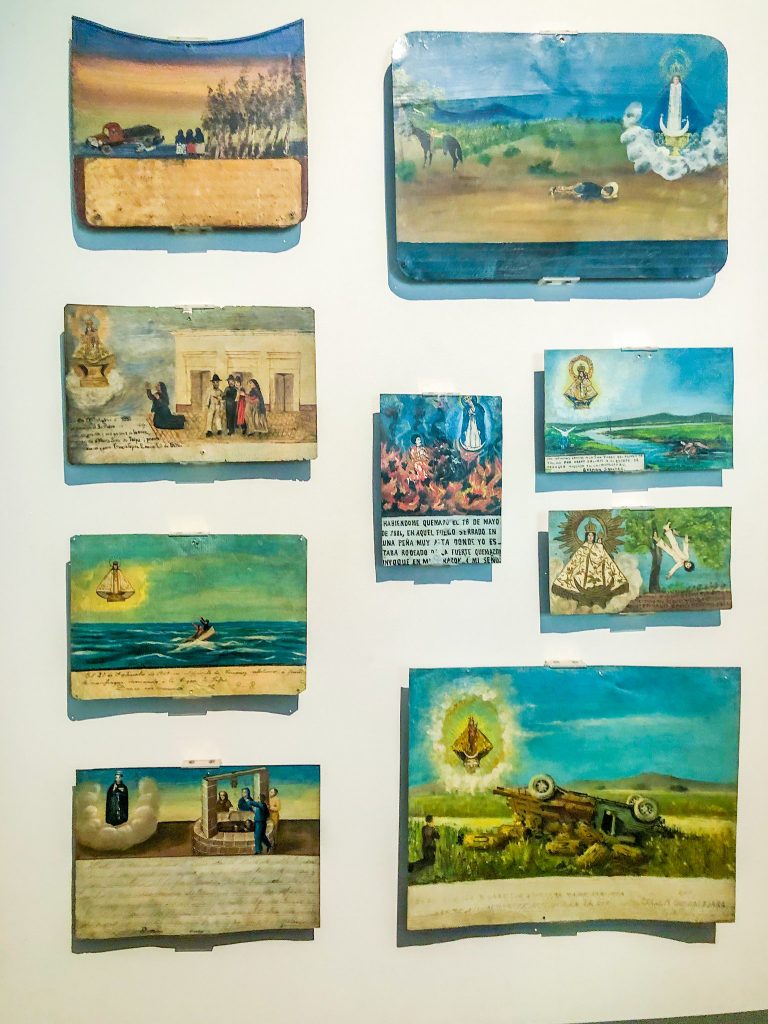
Judas Figures
Inside the next room are two towering figures in papier-mâché. These are mujeres bonitos or Judas figures from Tlatilco, Mexico. These “Judas” figures would usually be made of papier-mâché and filled with firecrackers that would explode on the Saturday before Easter. This tradition was thought to cleanse ones sins by burning effigies of that which represented evil. For Frida, she collected these effigies unburnt, perhaps as a symbol of sin unburdened.
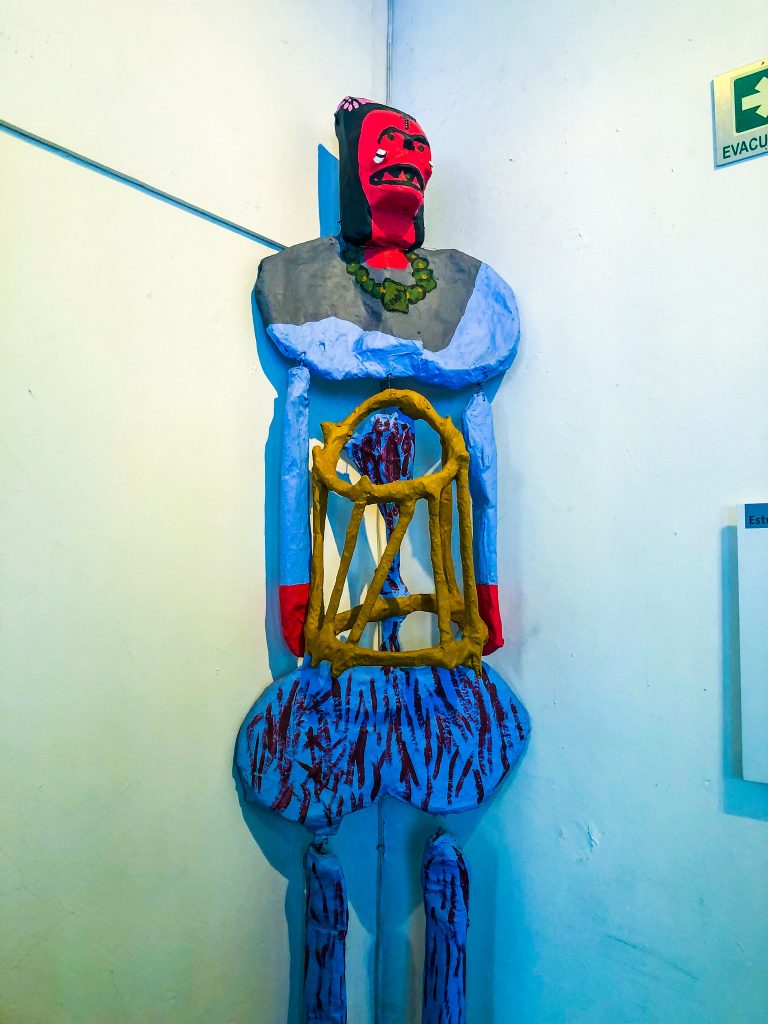
Frida’s Diary
In the last room are letters, newspaper clippings and selections of Frida’s diary, all found in the house when it was turned over to the city. Reading these lines from her journal is like sitting down with the woman herself. So often we lean on interpretations to understand what an artist was thinking or feeling, but here we have the words right from her own mouth. Her life was so fraught with sadness, and yet there is a hypnotic magic to her scribblings. Even if you can’t read Spanish, looking at the furious way in which she wrote is a way of understanding her emotional state at the time. Critiques wrote of her diary,
“The diary is the most important work Kahlo ever did…it contains energy, poetry, magic. They reveal a more universal Frida…In Kahlo’s paintings, you see only the mask. In the diary, you see her unmasked. She pulls you into her world. And it’s a mad universe.”
Dining Room
From the large sitting room, you step into the part of the house which has been preserved with all the old furnishings and decor that Frida had collected. The first room you enter is the dining room. The floors are painted bright yellow, almost neon! Most of the tables and chairs are painted the same colour to match, making them looks as if they grew out of the floor. Despite yellow often being associated with joy and cheer, Frida had a much different interpretation. She wrote in her diary, “yellow is associated with madness, sickness and, fear. It is part of the sun and of happiness.” To see this yellow spread all over her house feels like she was attempting to invite others to share in her madness.
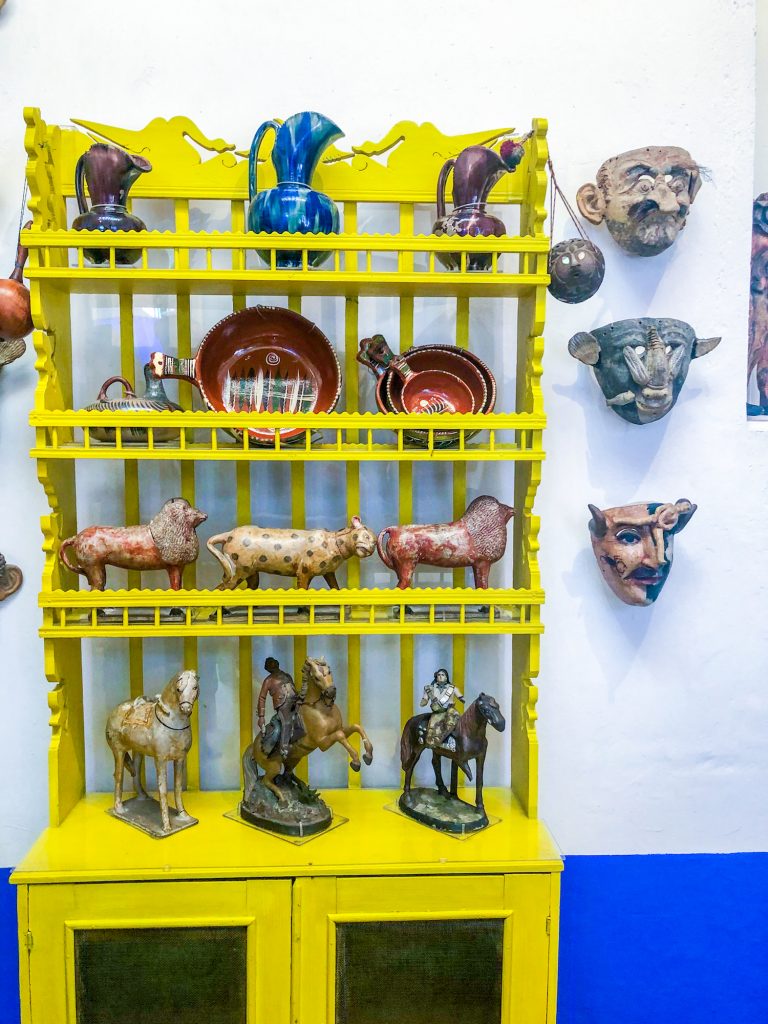
On the walls of the room are various, bright yellow shelves displaying Frida’s precious collections. In the 20th century, Mexican folk art was very under-appreciated in fine art collections. But Frida and Diego always saw its value and cherished collecting these items to preserve, even if just for themselves, elements of their Mexican heritage.

Guests in the Casa Azul
Around this dining table the couple entertained guests such as André Breton (French writer, poet and anti-fascist), Tina Modotti (Italian photographer, model, actress, and revolutionary political activist), Edward Weston (American photographer), Leon Trotsky (Russian revolutionary, Marxist theorist, and Soviet politician), Juan O’Gorman (Mexican painter and architect), Nickolas Muray (Hungarian-born American photographer and Frida’s lover), and many others.

On the shelves, in the dining room, we find two ceramic clocks. The hands of the clock do not move but are fixed on two different moments in time. The one on the left bears the date on which Frida decided to divorce Diego after discovering he was having an affair with her sister Christina. The other has the time when Frida and Diego decided to get remarried. By having this out in the open it proves how honest they both were about the problems inside their marriage. Their issues weren’t a secret and yet, in the end, their love for each other, especially inside these walls, feels eternal.
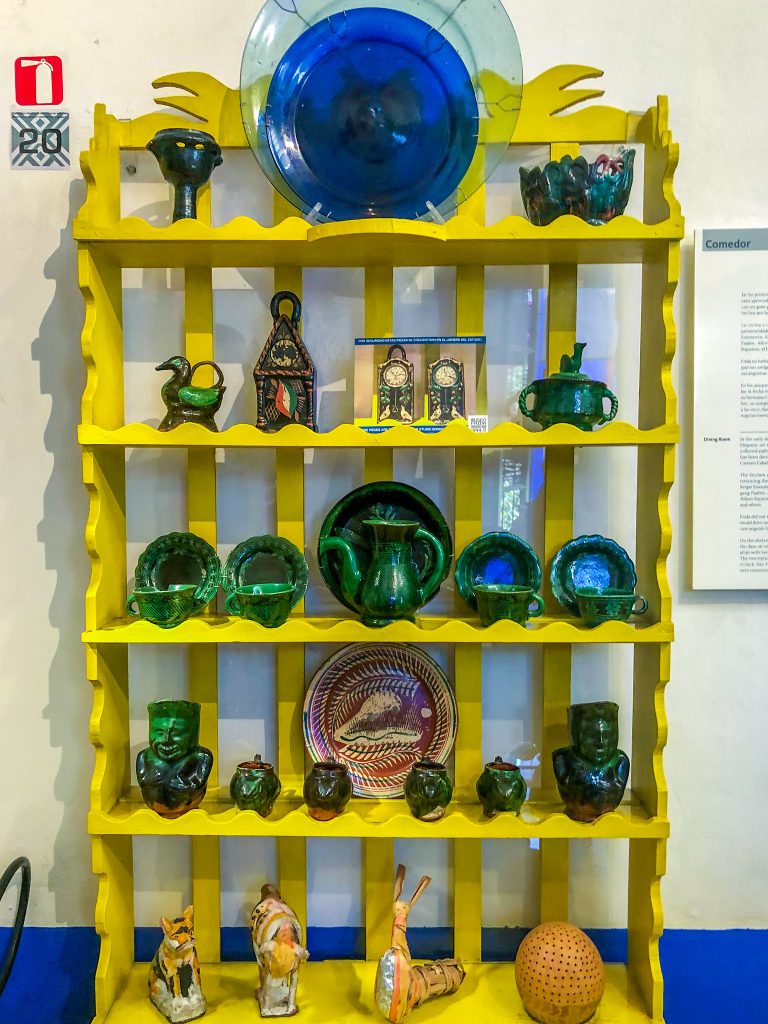
Diego’s Bedroom
On the other side of the dining room, is Diego’s bedroom. This small guest room was also used by Leon Trotsky when he stayed in Mexico City after fleeing the Soviet Union. After he and Frida had an affair, he was quickly removed from the house by Diego. On the walls of the room, hang Diego’s painting overalls along with his iconic hats he was always seen wearing.
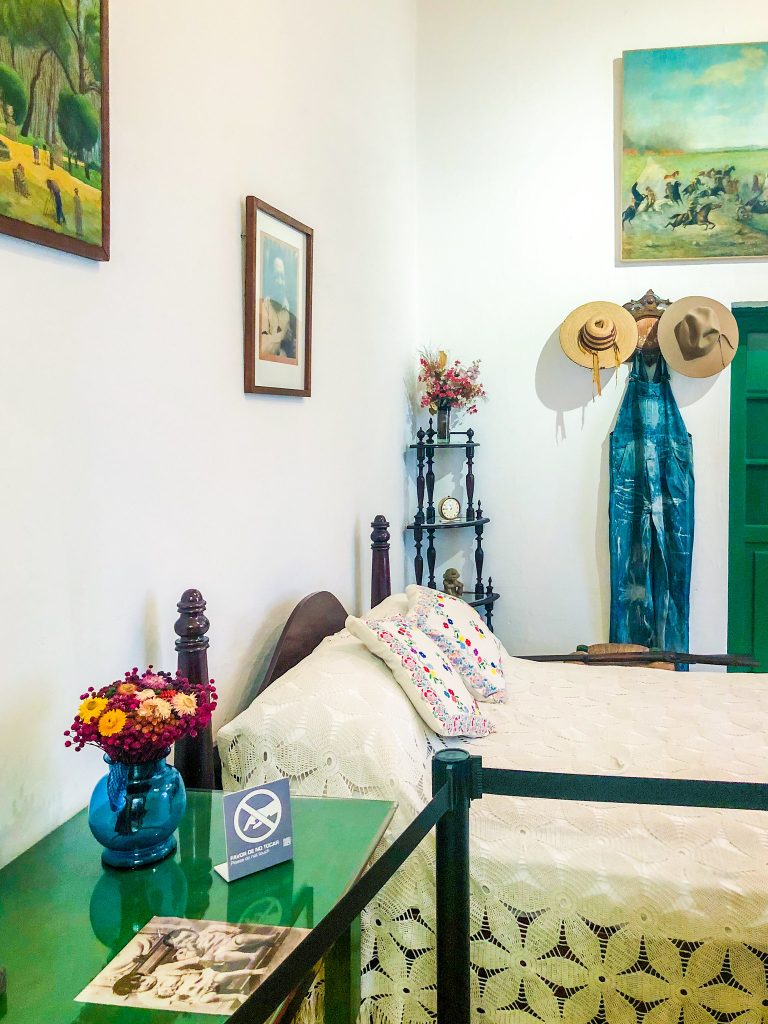
On the antique chair near the window is a small embroidered pillow with the words “Despierta Corazon Dormido” (Wake Up, Sleeping Heart) sewn in with rainbow thread. Words I’m sure Frida would whisper to her husband every morning upon waking him up for breakfast. Sitting on the dresser along the wall are various ancient Aztec sculptures along with Diego’s death mask. Around the room are multiple paintings, most of a highly sexualized nature, to reflect Diego’s passionate character.
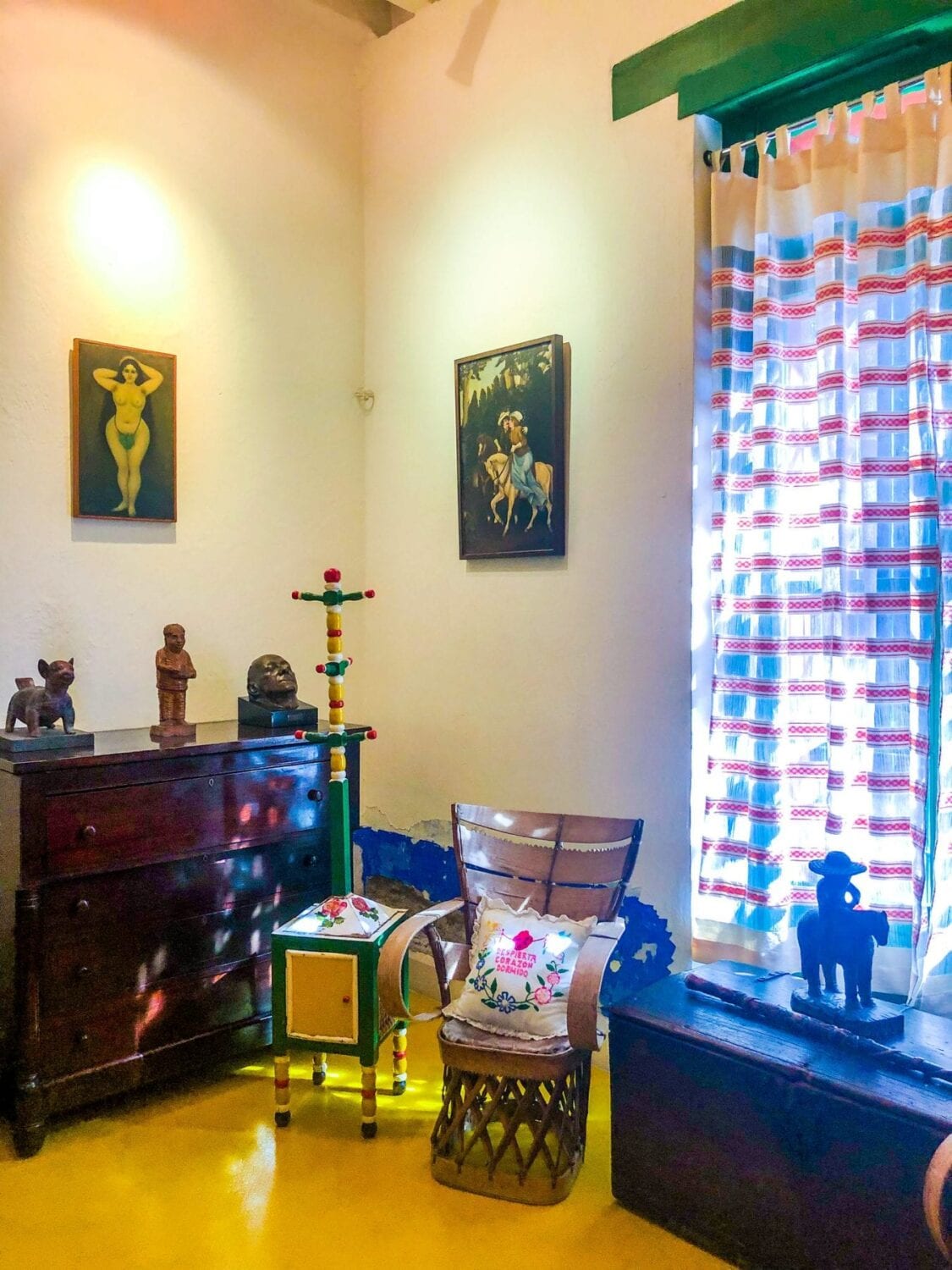
The Kitchen
The kitchen is one of the most elaborately decorated rooms in the house. The kitchen floor is painted the same bright yellow with Azul and yellow tiles trimming the walls. Along the walls are hung a variety of utensils, and tableware Frida used when she cooked. Frida learned how to cook from, of all people, Diego’s ex-wife. Lupe (his ex-wife) knew all of Diego’s favourite recipes and how important food was to him. Despite Lupe’s relationship not working out, she found deep affection for Frida and wanted the best for their marriage. Along the wall are dozens of miniature clay mugs which spell out “Frida + Diego” over the old stovetop. The old stove was never modernized from its original design and Frida still cooked using the woodfire while she lived there.
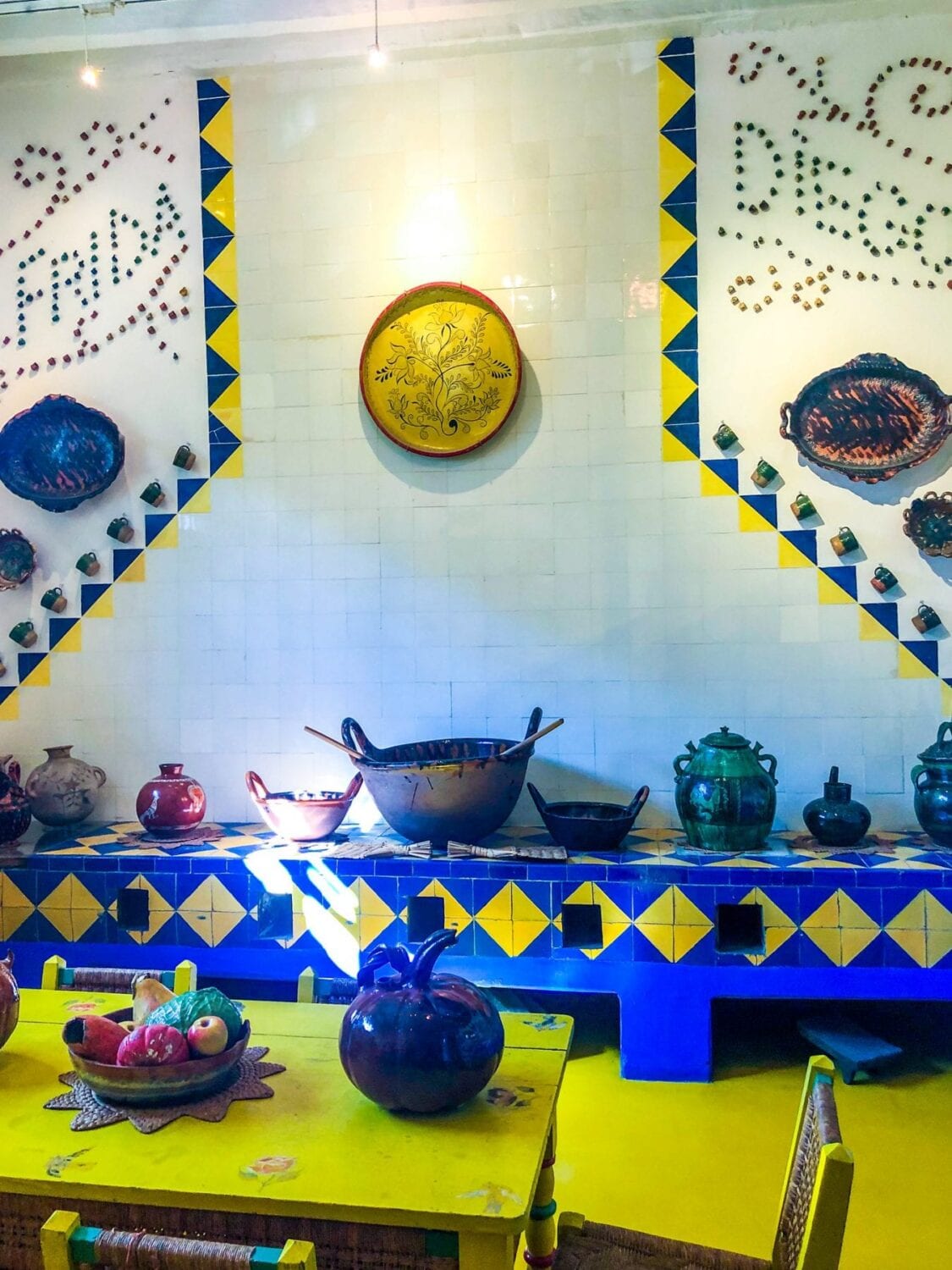
On either side of the window are these same clay pots used to form the shape of two doves, tying a lover’s knot. It seems everywhere you look here there are symbols of love. They often say, a way to a man’s heart is through his stomach. Often we see the kitchen as a more utilitarian space but Frida made it a room which bursts with romance and love.
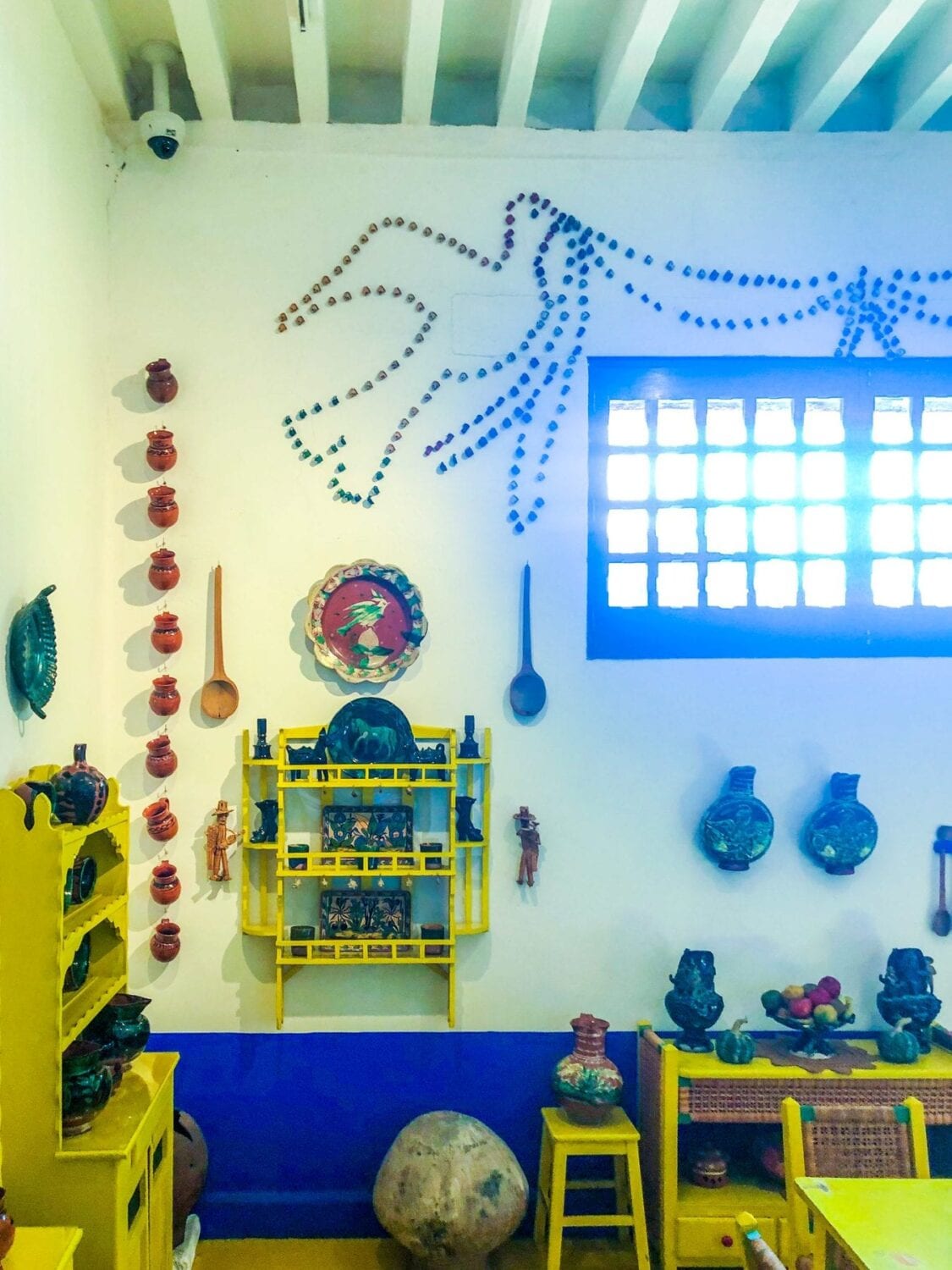
On her kitchen table are several vegetable-shaped clay tureens and terra cotta painted plates and pots. Nothing Frida used in her kitchen was mass-produced or “out of the box”. Everything was handmade and embellished with images of animals or traditional Mexican designs.
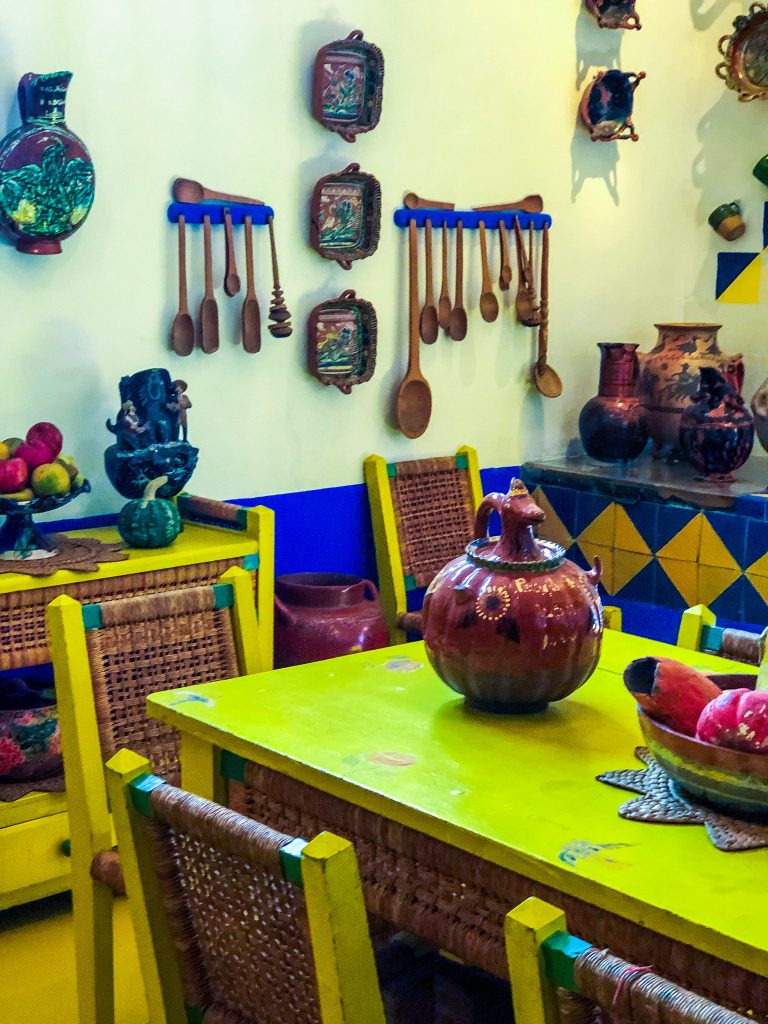
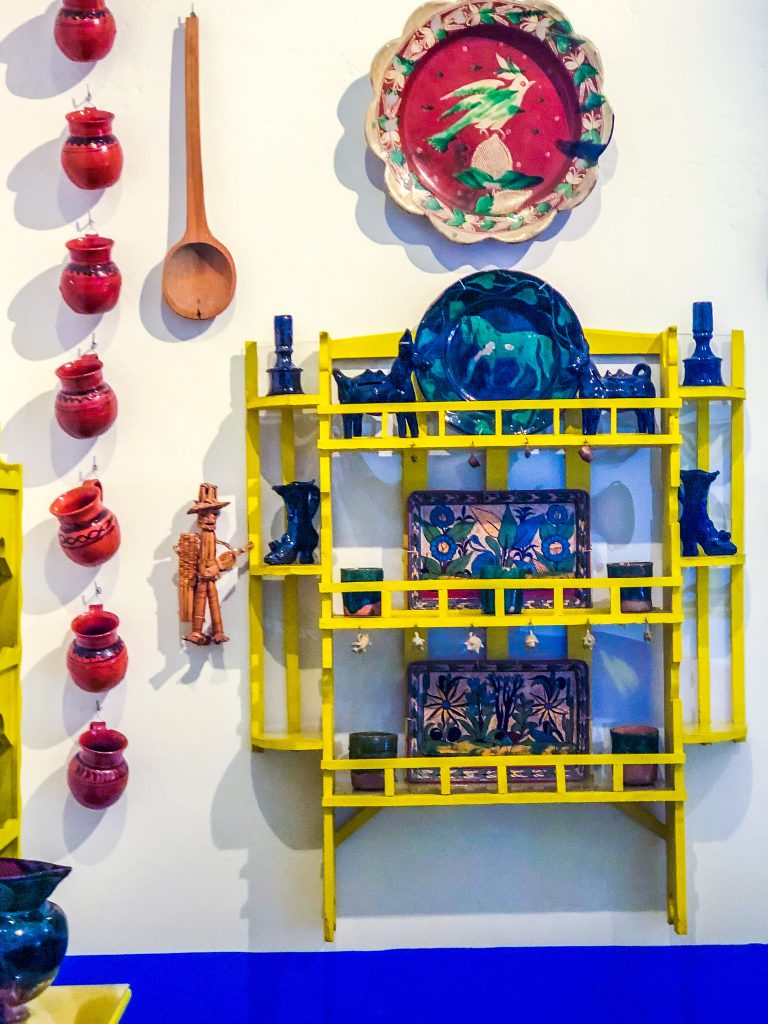
Stairwell
Moving from the first floor into the newly built second storey you pass through a small stairwell with sitting areas at the bottom. This tiny courtyard-like space is bursting with folk art objects, large paintings which crawl up the walls, taxidermied animals and some charming hand-painted pieces of furniture.
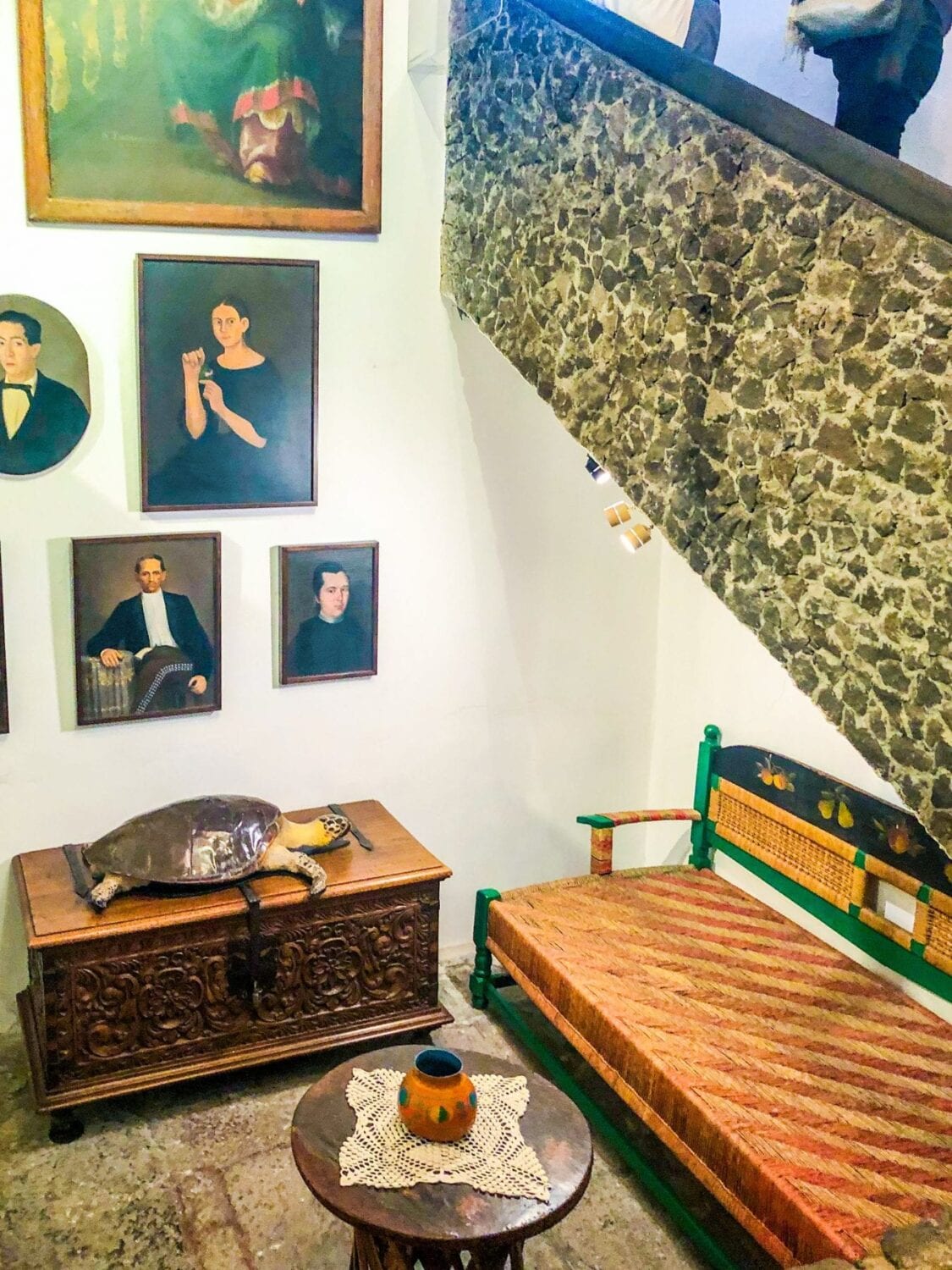
Frida’s Studio
Frida’s studio was built here because of her ever-worsening illnesses and disability. After the surgery to remove her leg, she found leaving her house to be very difficult. As such, Diego built this extension for her so that she could continue to work. The steel-framed windows are wrapped around the rooms to allow for light to pour in from the outside freely. From here, Frida could also look down into the garden, almost as if she was standing right in the middle of it. The blue of the walls on the exterior are so bright they reflects right into these rooms.
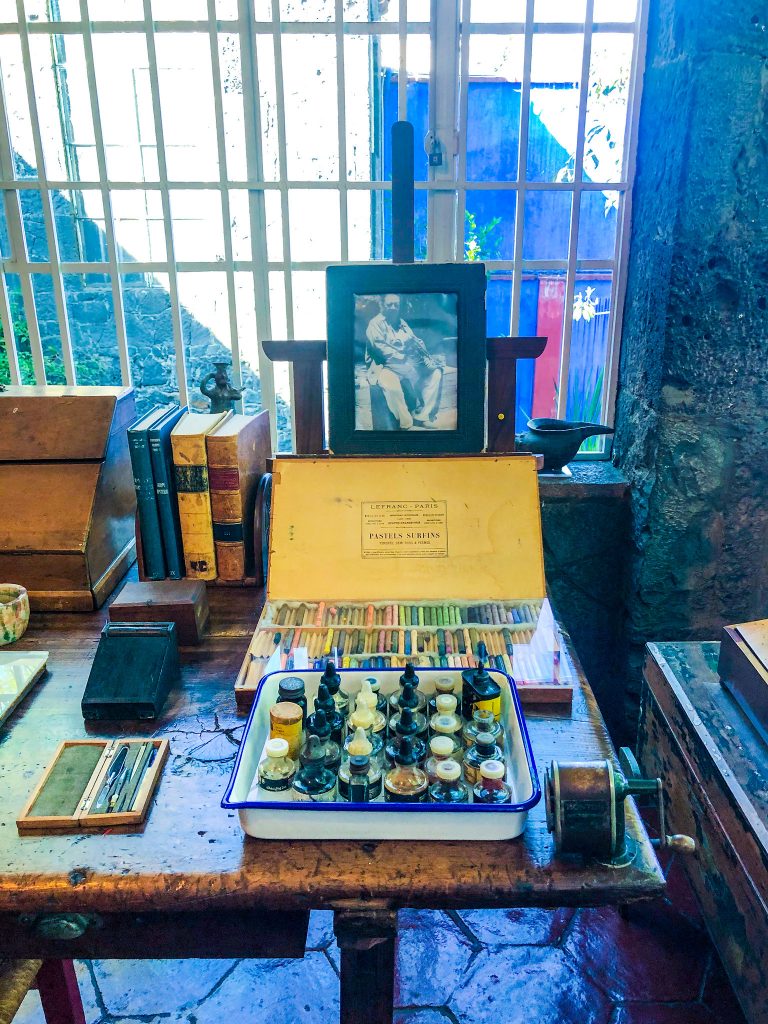
Painting Studio
Along the window is where Frida would work. She had a writing desk and an area for her easel where she would paint in her wheelchairs towards the end of her life. Today, her paints, brushes and pigments are all still laid out, as if awaiting her return. A mirror sits beside her workspaces, as she would frequently need it to paint the self-portraits she was famous for. She once said,
“I paint self-portraits because I am the person I know best. I paint my own reality. The only thing I know is that I paint because I need to and I paint whatever passes through my head without any consideration.”
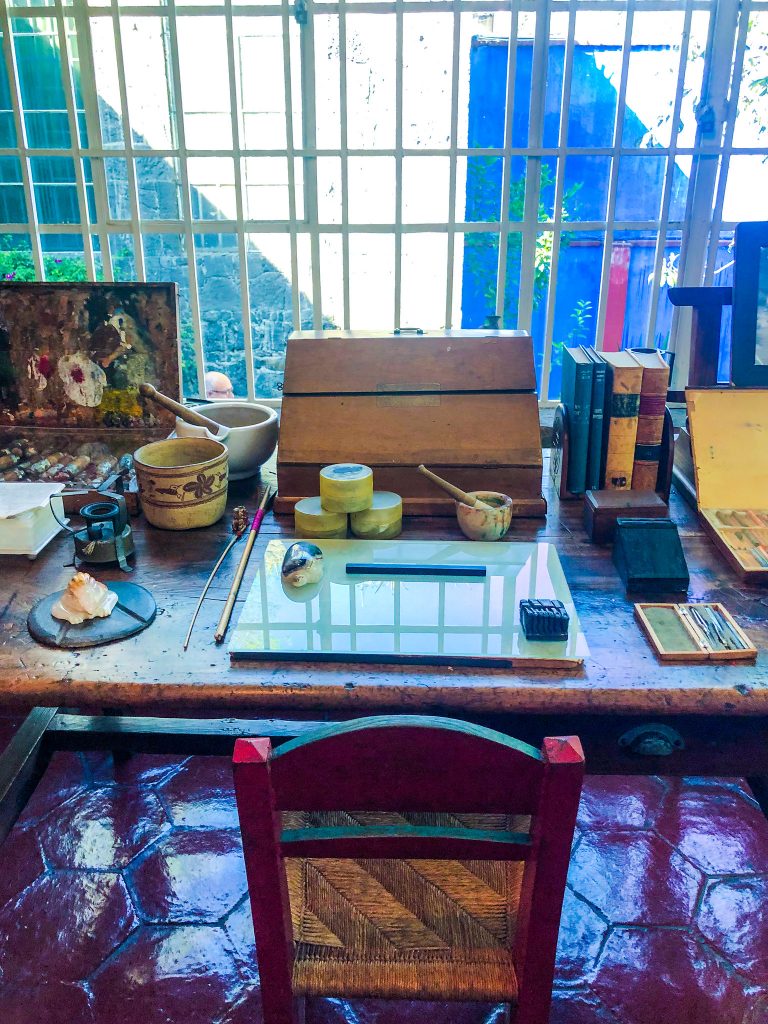
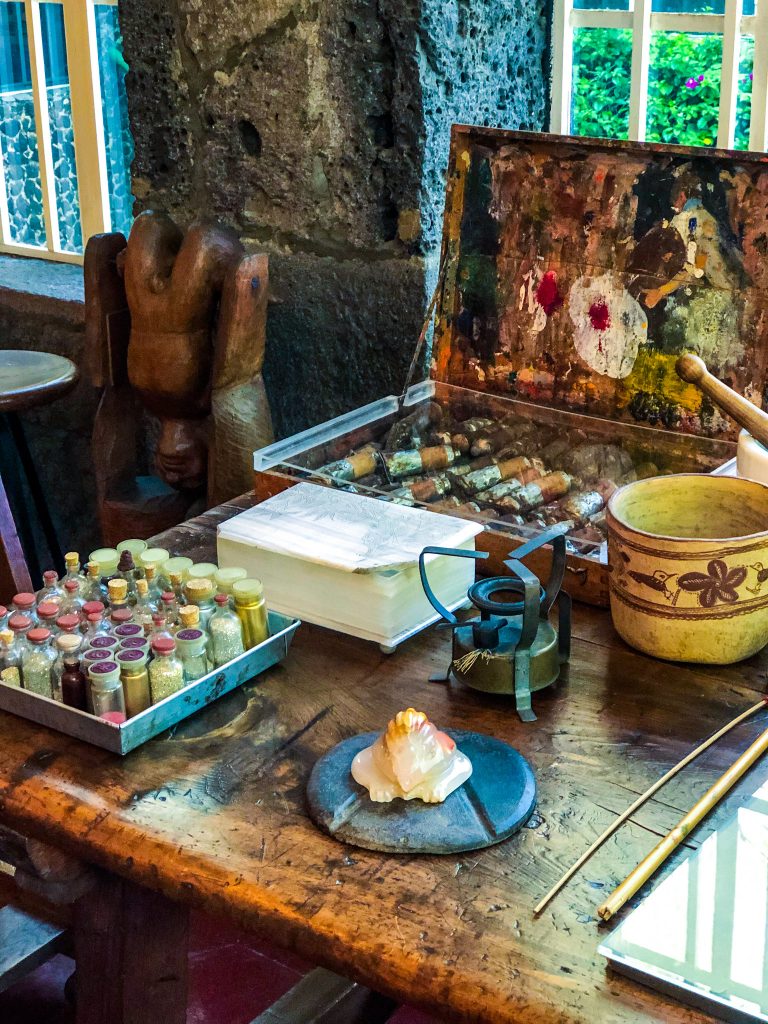
Sitting on the easel in front of her wheelchair is a painting she never finished, entitled “Still Life With Flag“. Towards the end of her life, she didn’t have the same control over the brush as she once used did. Her refined techniques were not quite there but her craving to paint was unabated. The easel was actually a gift to Frida from Nelson Rockefeller who came to visit them in Mexico City before asking Diego to paint a mural for him in New York.
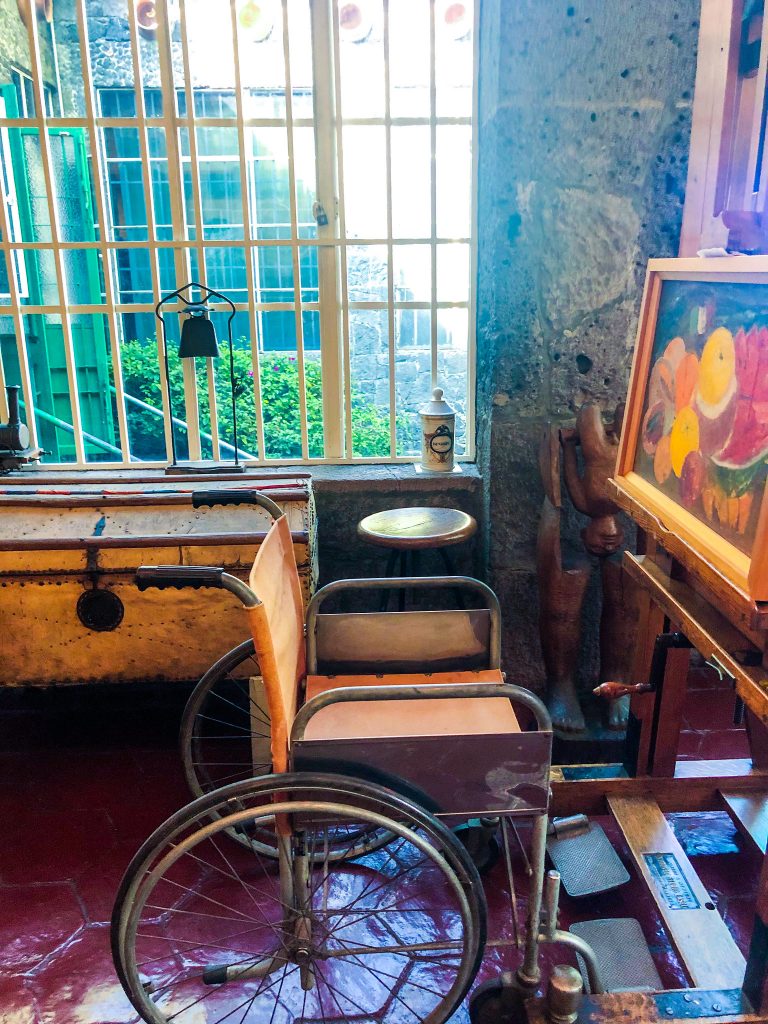
Book Collection
Along the walls of her studio are her collection of books. As a bibliophile, I spent way too long peering against the glass, trying to make out every single book cover and title. Kahlo, as expected, was obsessed with collecting antique books about Mexican culture and old atlas detailing the topography of the country. Inside the cabinets are also several precious items and souvenirs. When she was unable to walk, her friends would all come to visit her in bed. She would always ask them to bring something with them to remind her of the outside world. It helped with her connection to the world despite being so removed from it.
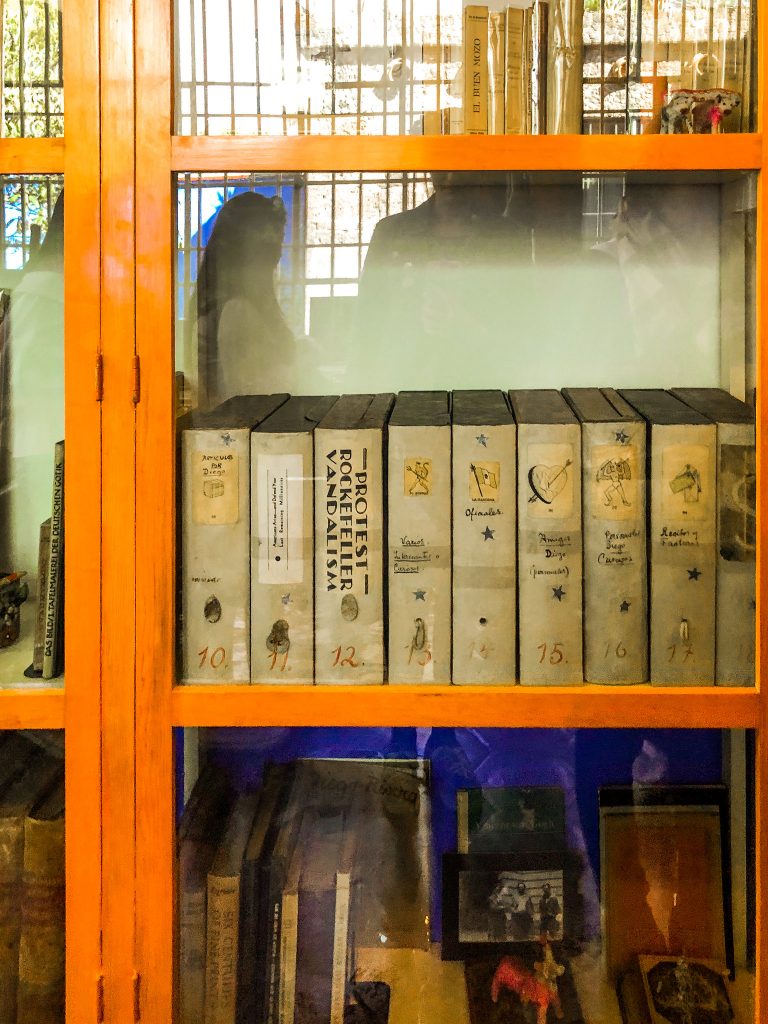
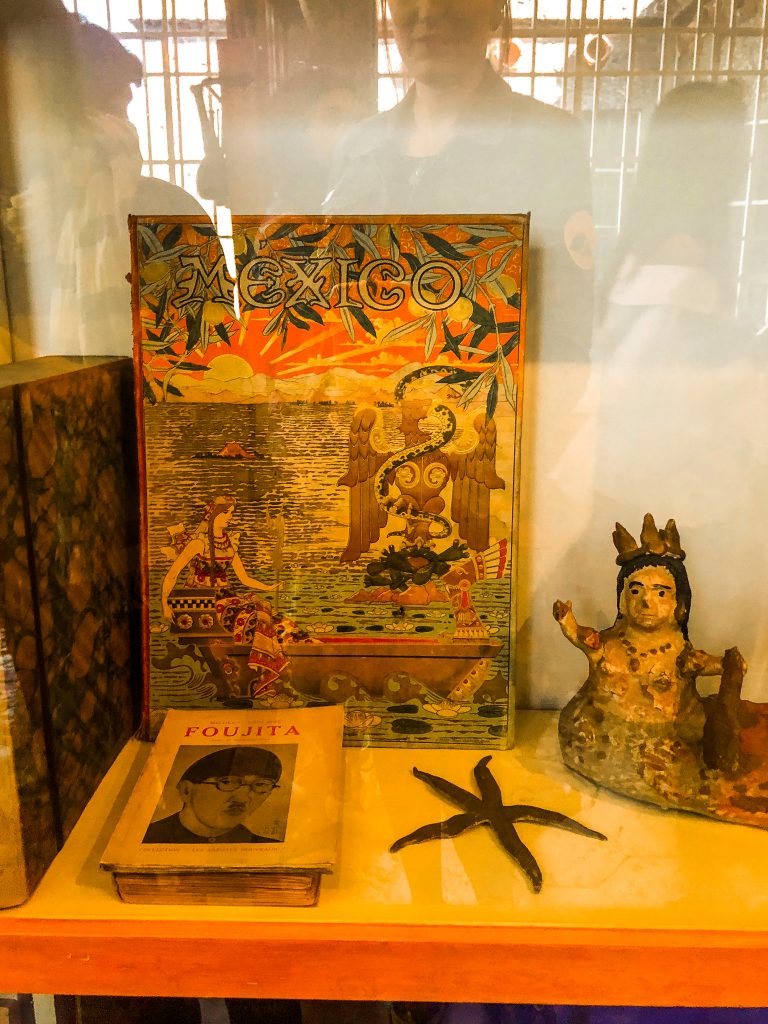
Cabinets of Curiosity
Hidden away in a cabinet are boxes and boxes of all the medications she had to take to deal with the pain she suffered from. In the cabinet are also dozens of bandages and other medical equipment. Here in her own house, it seemed like she had a mobile hospital of sorts. It’s truly incredible that in all this pain she could make so many beautiful things. I know when I’m ill I find it impossible to do almost anything. Truthfully, Frida has always been an inspiration to me during some of my more serious illnesses.
Thinking of all she managed to accomplish while suffering like she did would give me the strength I needed. On her walls of the studio is also a sizeable anatomical print of the “intra-uterine life of a fetus”. After Frida’s multiple miscarriages, she became obsessed with these images. Perhaps it was a way of processing what had happened to her. Like she was desperate to find meaning for her loss and that she wasn’t simply damned.

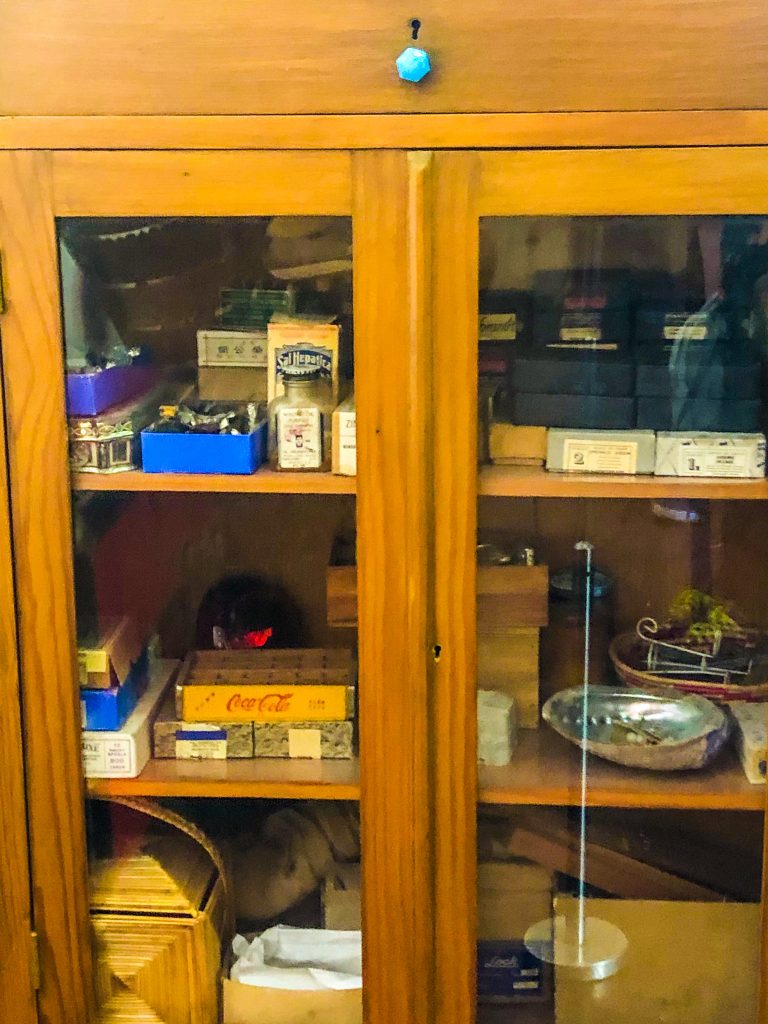
On the floor of this space, you’ll see several large colour trunks. These were what Frida’s clothing had been stashed away inside in those locked bathrooms.

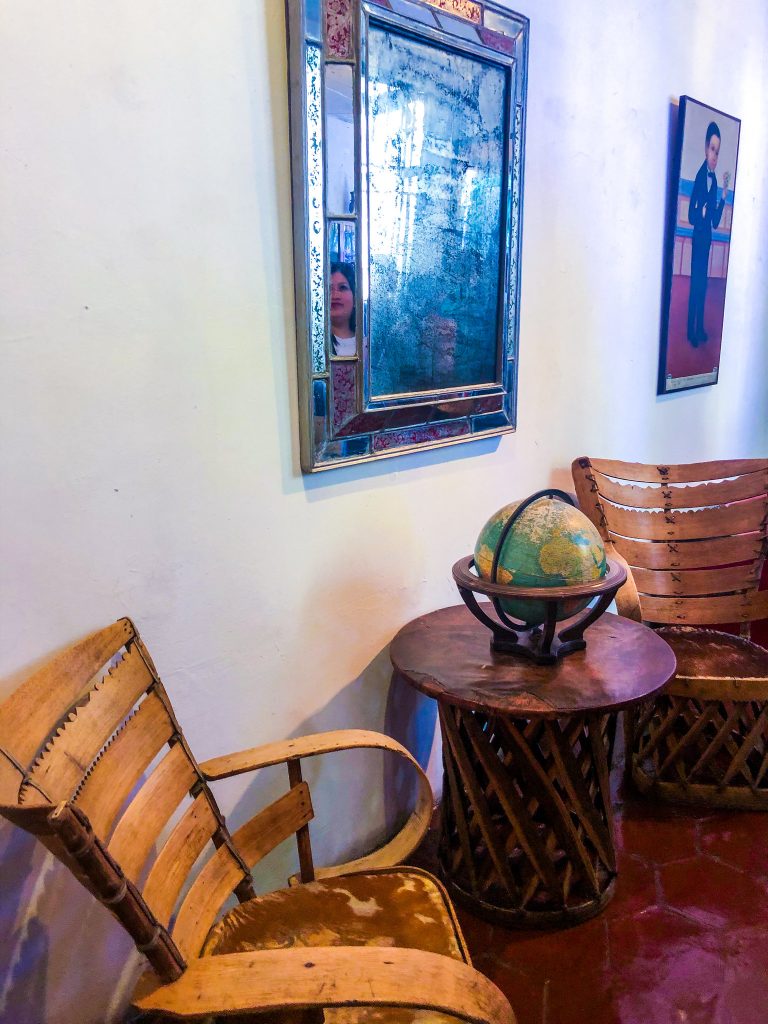
Day Bedroom
Frida actually had two different bedrooms built for her in this space. A daytime bed and a night time bed. As the names suggest, one was made for sleeping, the other, for her to lie in while she convalesced. Frida’s bedroom was left much as it was the day she died. Her tiny, four-poster bed was installed with a mirror on top so she could still paint her own self-portraits without needing even to lift her head. You can see this mirror for yourself and picture her lying there, looking up at herself, wishing to be anywhere be there. On the walls at the foot of the bed, are a series of portraits of Lenin, Stalin, and Mao Tsetung. In the corner of the room are a pair of her old crutches.

As this was the bedroom where she would do her painting, there is still a side table with various paints and brushes at hands for her if inspiration would strike. On the wall, there is a small bookshelf with some of the books she was reading before she died. Above them a grouping of photos, one of which is a picture of herself taken by her lover photographer Nickolas Muray. Above her bed is a painting of what we can only assume is a dead child with a garland of purple poppies around the frame. Photo of children who past away were popular in the Victorian era, as a means of memorializing them. We can only assume who this child was to Frida. Perhaps it was a protector or the image of what she imagined one of her children to be if she had grown up even a little.
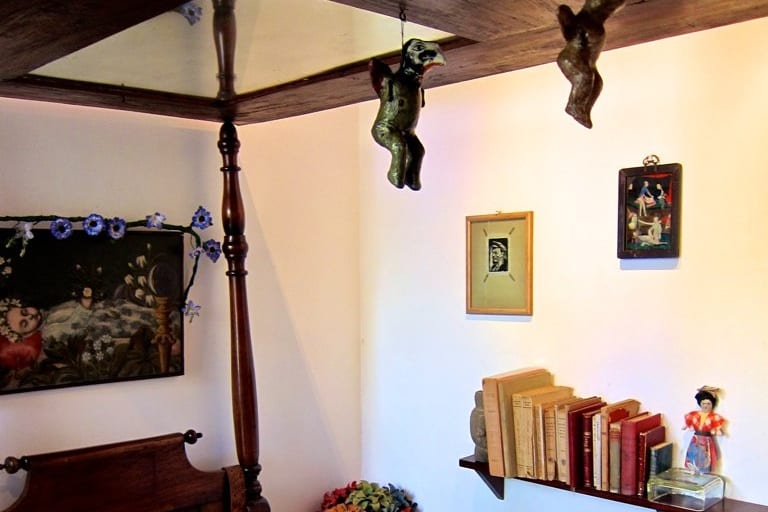
Death Mask
Sitting on her little daybed, wrapped in one of her favourite shawls, is Frida’s death mask. They change the shawls out throughout the year depending on the season, just as Frida herself would have changed her outfits up based on the time of year.

Night Bedroom
Her night bedroom feels a little more whimsical and, appropriately, dreamlike. Above the bed, looking down at her, instead of her own visage was a frame full of butterfly specimens given to her by Japanese-American sculptor Isamu Noguchi. When asked about her disabilities Frida would often respond, “Feet, what do I need them for? If I have wings to fly.” Up with the butterflies were also a series of hanging dolls. Perhaps Frida saw herself in these dolls, flying above the world with the butterflies.

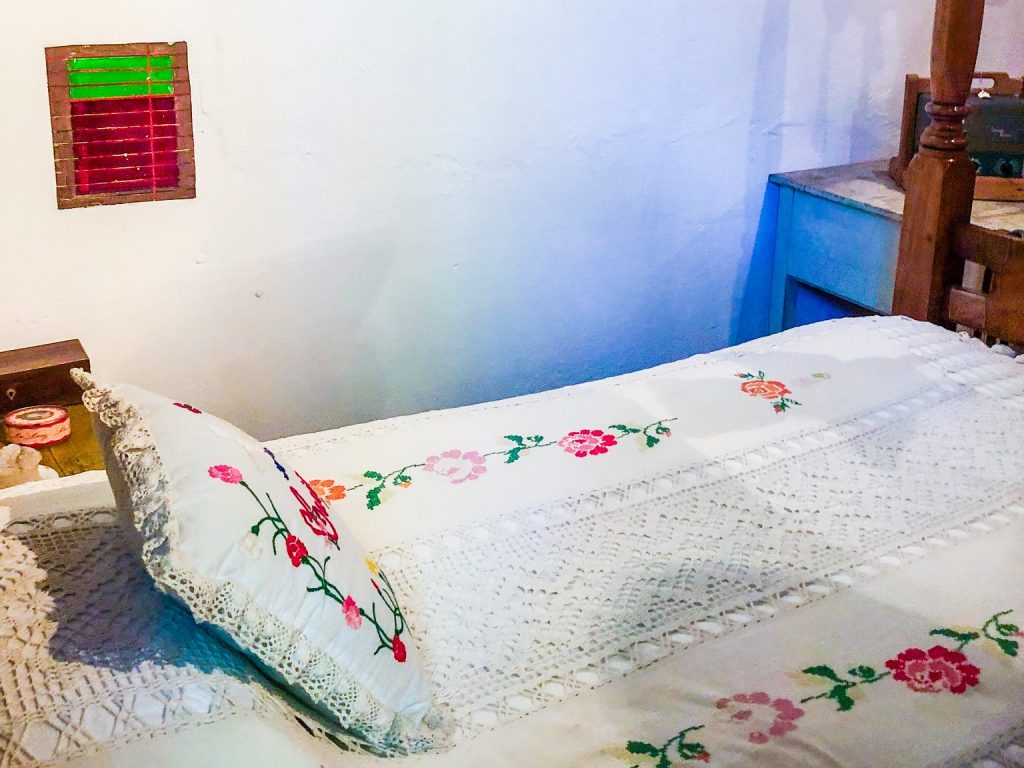
On her bed is a pillow, embroidered like the one in Diego’s room, with the words “Do not forget me, my love.”

Across from her bed, on a laced-topped table, is a headless pre-Columbian urn which contains her ashes. The urn is in the shape of a toad, which was her nickname for Diego. Even in death, she is literally inside of him.

In her night bedroom is a large green cabinet containing an extensive collection of her childhood toys. Green to Frida represented “good, warm light” and perhaps her childhood (before her polio) was one of the most cherished times of her life. Against the wall is a tiny bench with Frida’s name and the year 1910 written upon it. It is one of the only pieces of furniture from the previous household which remains.
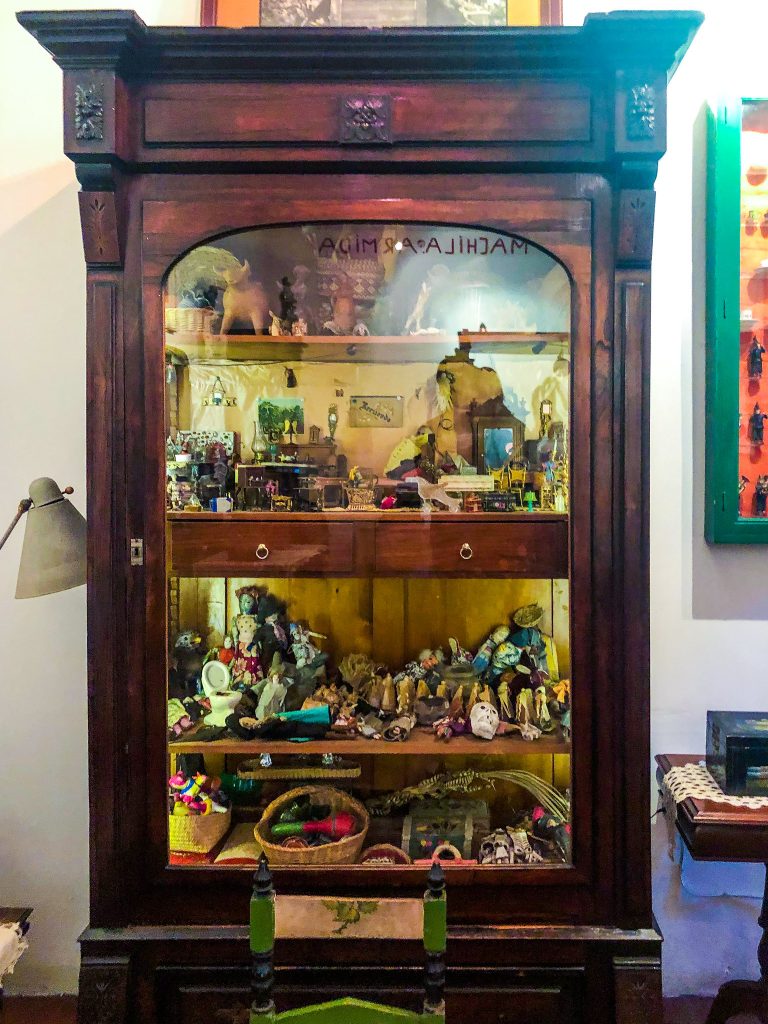

In the corner of the room is a green and white coat rack, with little flowers dotting the surround. Upon it is one of Frida’s extra headscarves. You can imagine Frida standing here in the natural light of the morning, putting on layer up layer of clothing, jewellery and perfume, her mask to face the day.
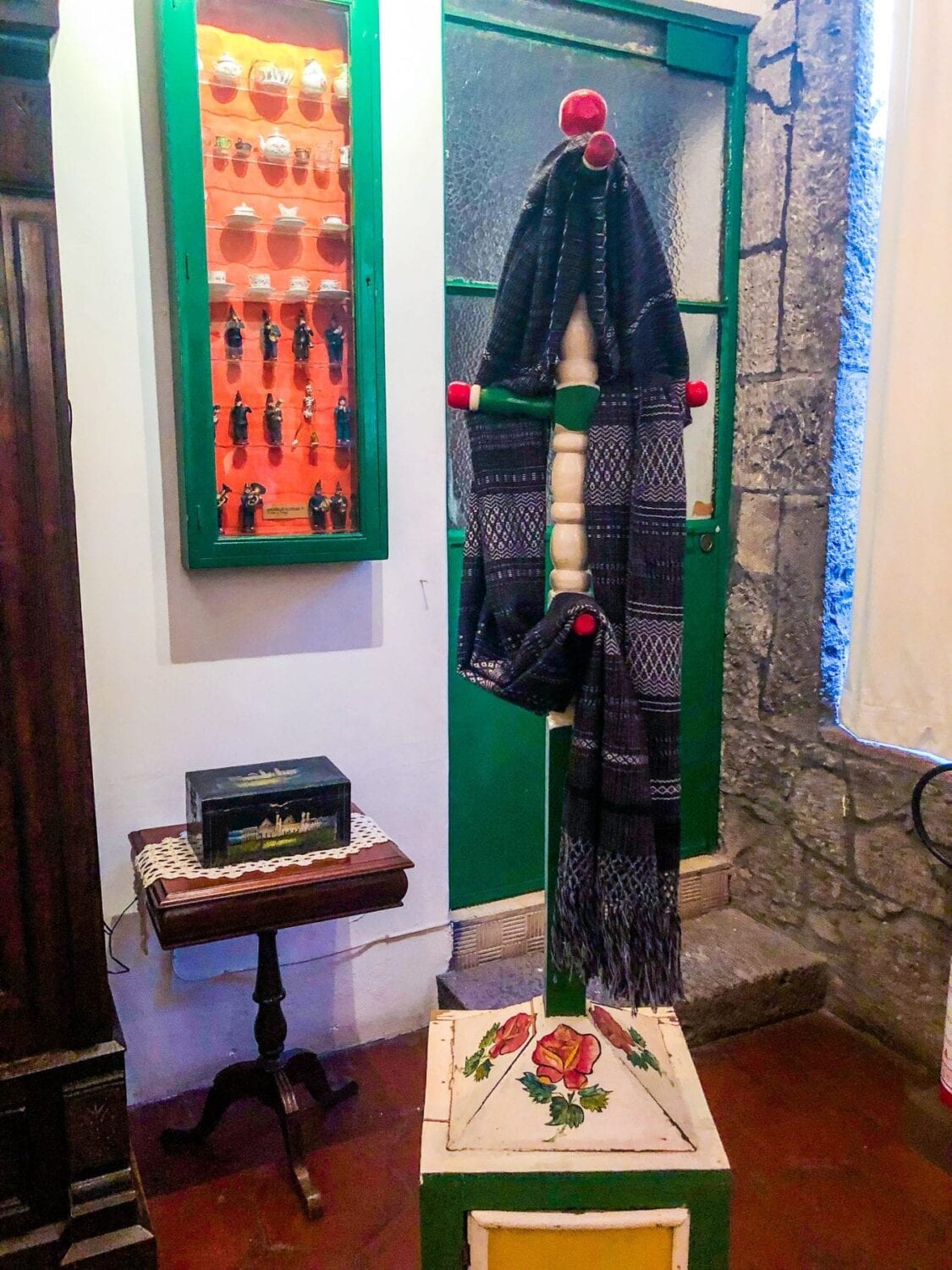
Stairs down to the Garden
The stairs which lead back down to the garden are located opposite her daybed. The large doorway to the garden allowed for so much natural light to flood into Frida’s room so she could better see what she was painting. The stairs lead down to the reflecting pool where I imagine Frida would have come to sit and contemplate, the sound of nothing but the birds and the wind in the trees surrounding her. The truest peace she could find.


Visiting the Casa Azul, I genuinely think is as important as anything else you’ll do in Mexico City. Even if you don’t know of Frida or even perhaps aren’t interested in her artwork, this museum is so much more than a gallery. It’s a glimpse into the life of a woman who changed the future of females artists forever. She took it upon herself to preserve and share her love of Mexican indigenous cultures. And today, the image of Frida, in her traditional colourful dress and floral headpiece, is as iconic as the Mona Lisa.
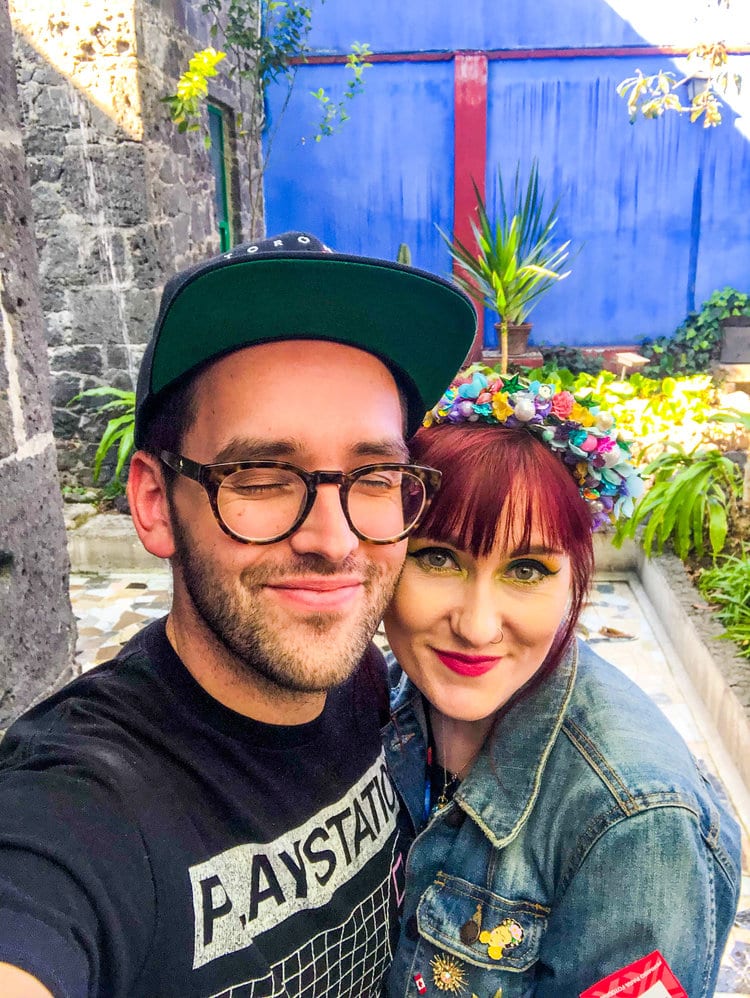
Me and my Diego 😉
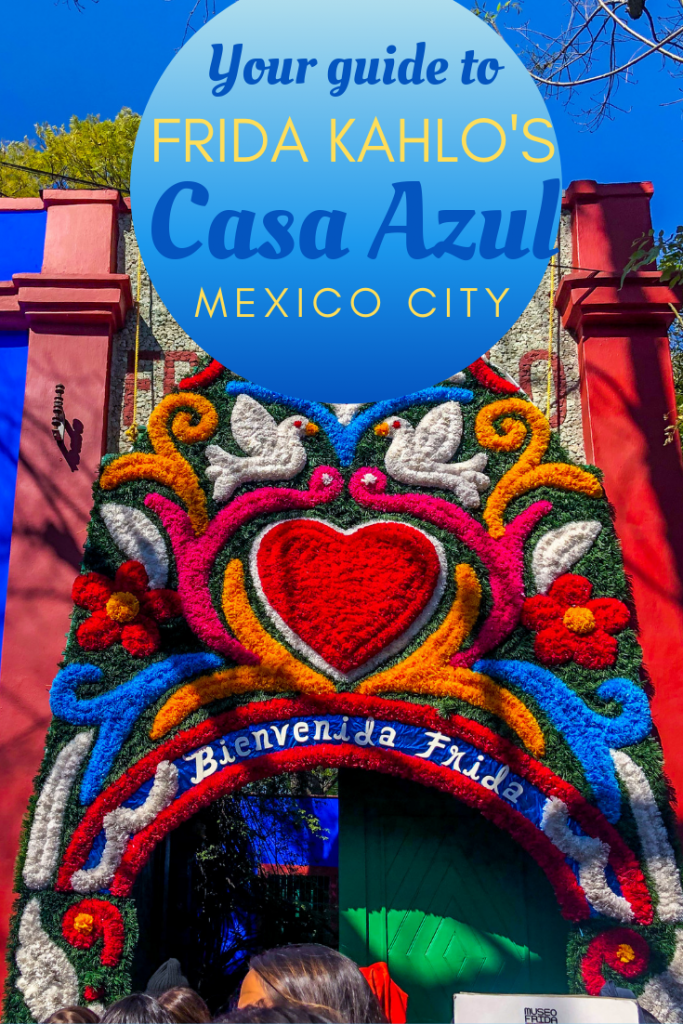
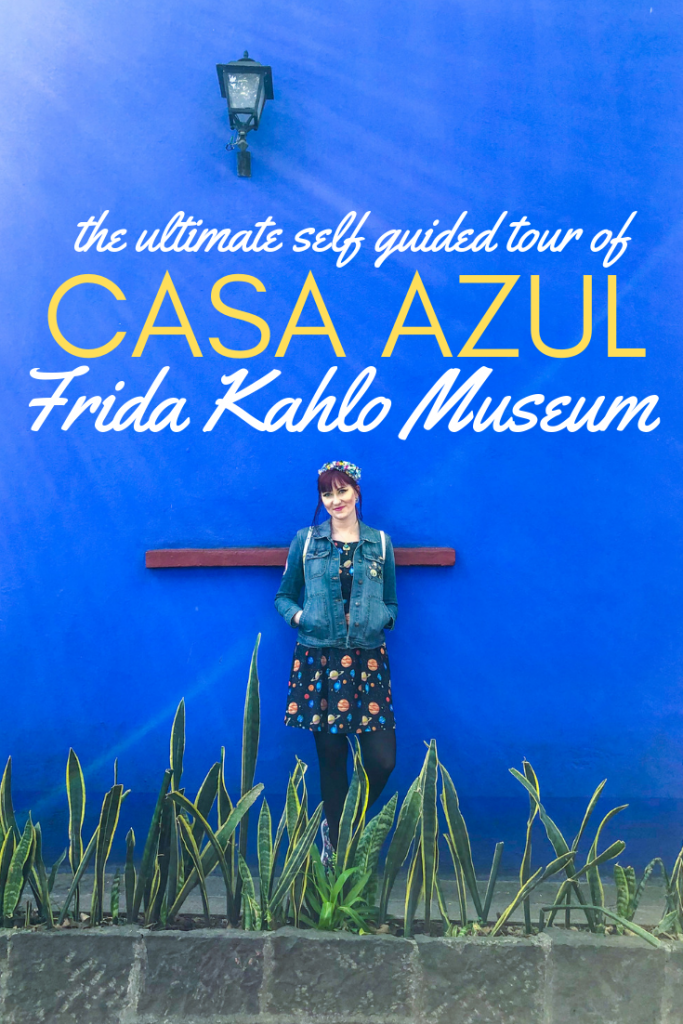
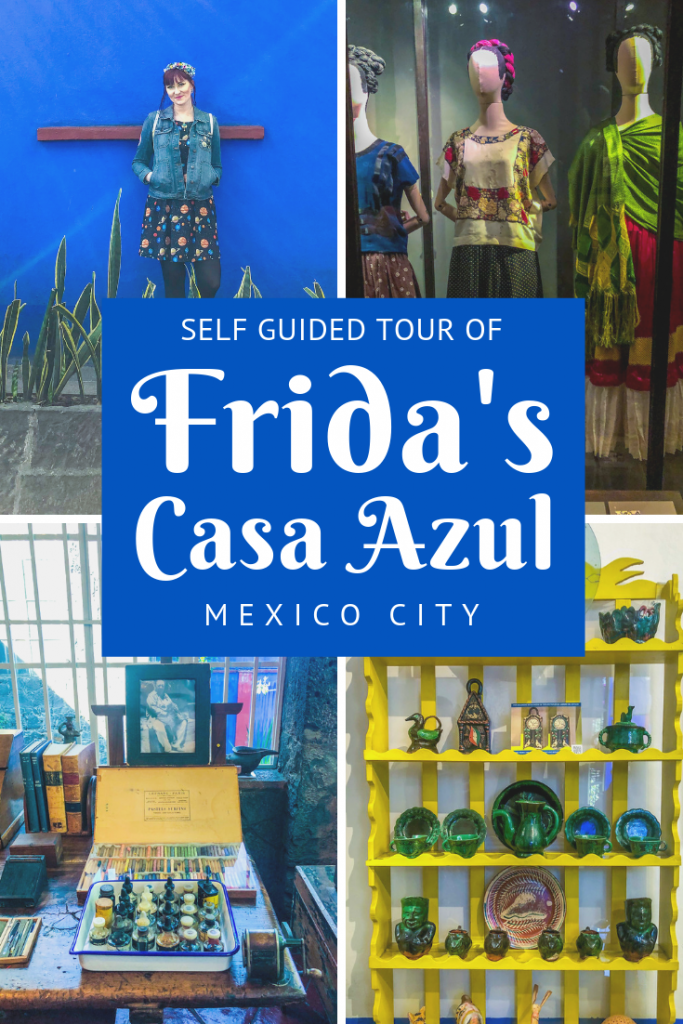
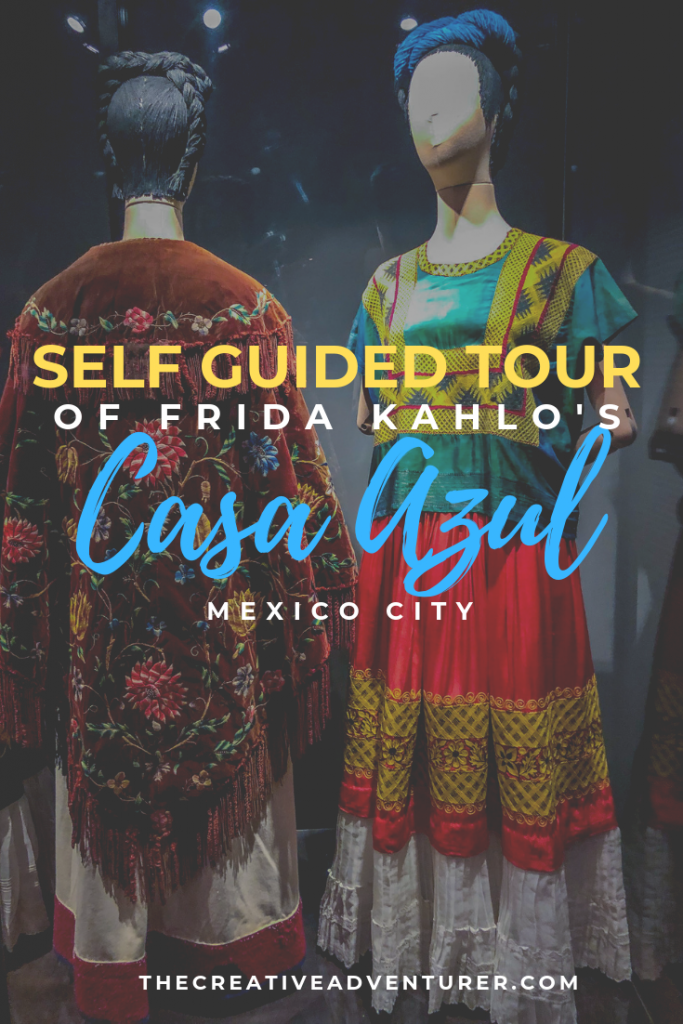


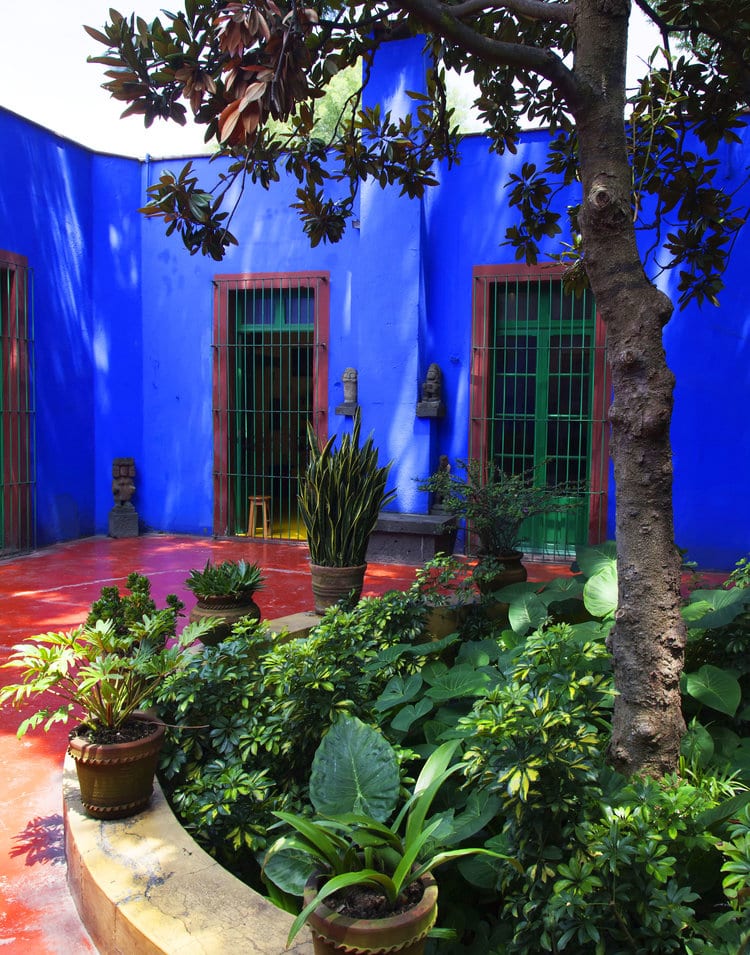

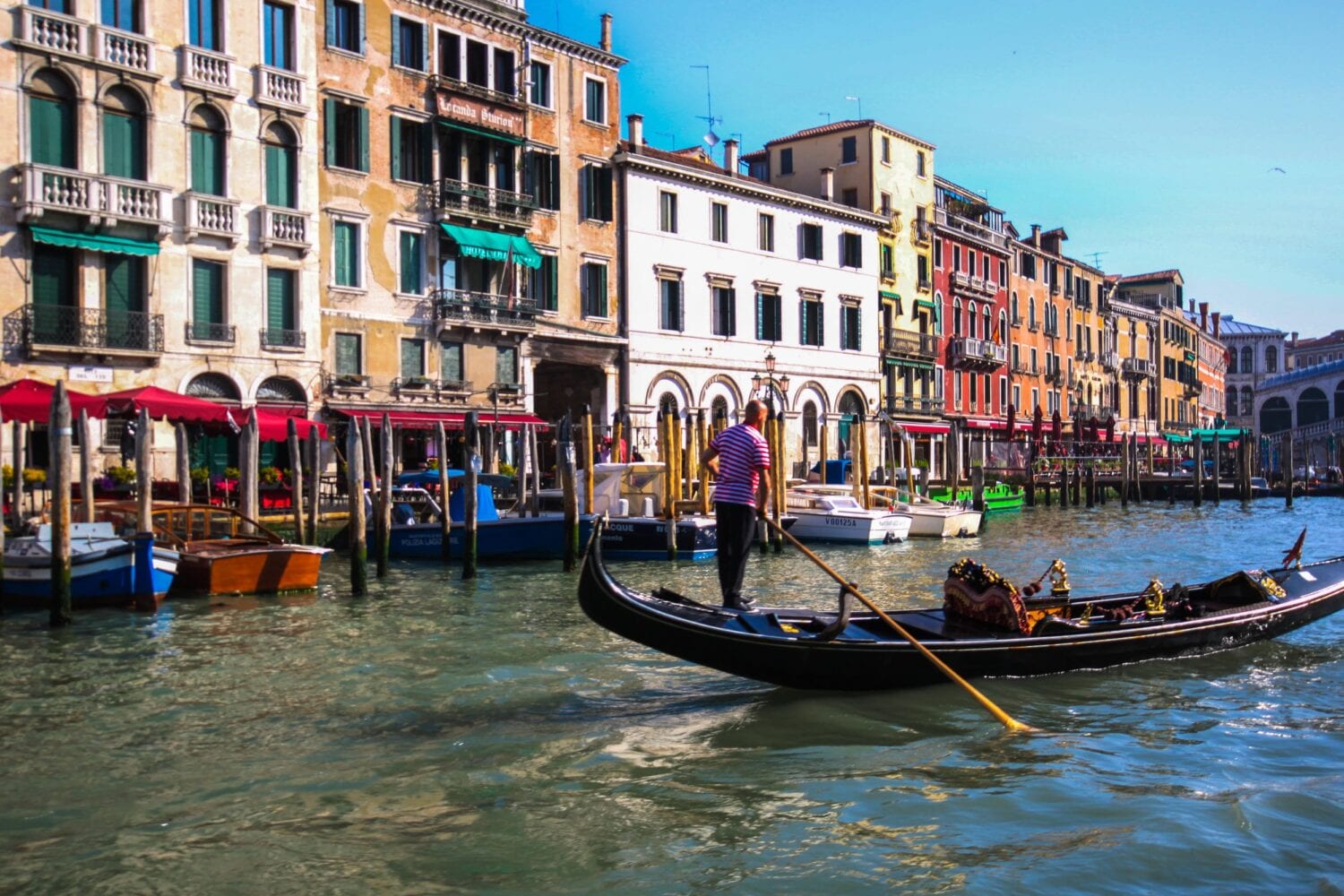
11 COMMENTS
Anna H
4 years agoThis was amazing! Thank you SO much for the tour, photos and details. My daughter is doing a report on the museum and has to give a virtual tour to her Spanish class with details about everything in certain rooms. There was so much that you shared that we were unable to find elsewhere. Also, you are an excellent writer 👏.
We may go to Mexico city later this year so I am going to be reading much more of your work!
laura.f.whelan
4 years ago AUTHOROh wow!!! Thanks so much Anna!! That honestly is so wonderful to hear. What a great idea for a class presentation, the virtual tour will be a great way to show the class all about the house. I hope she has an amazing presentation. It really is such a magical home, so many little details I’m sure I missed so visiting it for yourself is something you definitely need to do when visiting Mexico City! Any questions you have about visiting let me know, it’s one of my favourite cities in the world and I’m so passionate about talking about all the wonders that you can find there.
Clare
3 years agoWhat a fascinating page – I have been literally transported this morning!
laura.f.whelan
3 years ago AUTHORThanks so much Clare! That’s the highest compliment I could ask for 🙂
laura.f.whelan
3 years ago AUTHORAlso, WOW I just checked out your website, you are an incredible artistic talent yourself!!!
Nora N Chavez
3 years agoWow! This is the best post on Frida’s House I’ve seen. I’ll have to bookmark it. It was such as wonderful experience being there and this brought back many wonderful memories of Mexico City. Thank you so much for sharing.
laura.f.whelan
3 years ago AUTHORThanks so much Nora! It truly is my favourite place in the world as well. I’ve even transformed my dining room into a tiny slice of the Casa Azul and it bring me so much joy to sit in there. I’m so happy you enjoyed this post and sharing your lovely comment with me 🙂
Pamella
2 years agoI have just returned from my first visit to Mexico City and the Casa Azul. I wish I had seen your post before to use as a reference! Although I did see many of the items you pointed out, I somehow missed many others. I will return someday and will reread the notes you have made here to better understand the artist and her life. Thank you so much !!
Julie
1 year agoThank you so much for creating this detailed tour of casa azul! The museum didn’t have any audio guides when I visited and I didn’t want to miss out on the meaning and symbolism in her artwork and possessions. This was so helpful!
The Creative Adventurer
1 year ago AUTHORYou are so welcome Julie! I’m thrilled that this post was able to add so much to your visit.
Jon
9 months agoWe used your post as a guide in going through the museum today. Thank you!